Introduction
The Dissolution of General Education: 1914-1993
This study was inspired by the current national debate over the structure, content, and rigor of higher education in the United States. Such a debate, of course, is scarcely novel, as a cursory glance at the academic landscape over the past century reveals. Previous episodes, however, did not match the duration and intensity of the present round, which has continued without resolution for more than a decade. Also noteworthy is the extent to which today’s educational issues have engaged public interest outside academic precincts, so that pedagogical priorities are being examined well beyond the confines of college departments or curriculum committees.
Perhaps the most frequently and furiously debated question has centered on precisely what undergraduates should know: is there a body of knowledge with which they should be familiar, regardless of their major fields of study? And invariably linked to this question is another: what do today’s undergraduates in fact end up knowing? What actual knowledge is likely to be imparted during the four years or more devoted to the pursuit of a baccalaureate degree, particularly in the liberal arts?
Beyond the philosophical searching that provides much of the debate’s energy, the uncommon public scrutiny reflects practical considerations as well. For example, many, if not most students seek postsecondary education because the baccalaureate degree has become nearly indispensable in many areas of employment. And parents—harboring memories of their own collegiate experiences—are curious to learn what their sons and daughters are receiving in return for the often very ample tuition they now have to pay.
In the debates over what students learn and ought to learn disagreement most commonly arises over whether the curriculum should be expanded to make it more “inclusive,” “diverse,” and “multicultural.” By contrast there remains an apparent consensus that a good undergraduate education is one that makes students broadly familiar with major areas of learning. Claims to provide such an education are a standard feature of contemporary catalogues even at institutions considered most academically “progressive.” Stanford University, for example, claims that:
As do all major universities, Stanford provides the means for its undergraduates to acquire a liberal education—an education that broadens the student’s knowledge and awareness in each of the major areas of human knowledge, that significantly deepens understanding of one or two of these areas, and that prepares him or her for a lifetime of continual learning and application of knowledge to career and personal life.1
The statements of administrators echo similar curricular commitments. Yale University president Richard C. Levin answers the question, “What should be the content of a curriculum designed to provide a liberal education?” by saying that: “Surely the student needs acquaintance with certain fundamental modes of organizing experience: mathematics, empirical science, historical, philosophical, and literary interpretation. This is the basis for the distribution requirements that most American colleges impose upon their students.”2
It is hardly surprising that many colleges and universities continue to claim that their students receive this type of exposure. In a democracy, a competent citizenry, to say nothing of an effective leadership, should possess a familiarity with the history of its country and the world at large; conversance with major philosophical, literary, religious, and political traditions; understanding of the nature of the natural sciences and their signal achievements; and an ability to think, speak, and write with clarity and purpose. Those pushing hardest to expand the traditional undergraduate curriculum rarely deny the importance of these attainments. Rather, they argue that existing curricula adequately develop them but need a further enlargement of scope. There has been, to be sure, worry among other critics of contemporary practice that traditional studies have fallen into neglect. Indeed, at a number of institutions attempts have recently been made to revamp and presumably intensify students’ intellectual experience of them. Still, such efforts have not been undertaken with anything like the degree of concern, urgency, or moral passion mustered in the cause of greater “inclusiveness.” Except for a small band of educators derisively labeled “conservative,” it has been hard to find observers or—even more to the point—representatives of America’s higher education leadership who believe that very serious problems exist concerning the teaching of traditional subject matter.
Given that there remains a general, if rather abstract, agreement on the importance of studying “traditional” subjects, how do contemporary requirements in these domains compare with the requirements of times past, especially that past still alive in the recollections of those now seeing their children and grandchildren off to college? The memories of such individuals are often the basis for their expectations of what today’s students will experience, and hence of the quality and value of contemporary higher education. But are these expectations valid? Or has the general education curriculum changed so much in living, or even recent, memory that the broad exposure to basic subject matter once taken for granted is no longer guaranteed?
In embarking on this study, it was our central hypothesis that general undergraduate education has in fact changed substantially—far more, certainly, than most of America’s higher education leadership has been prepared to acknowledge. We also expected to find that these changes had the effect of largely removing from the general education requirements those courses that provided students with basic surveys of such standard subjects as history, literature, philosophy, and the natural sciences. Finally, we hypothesized that when contrasted with the changes that had been made during the earlier decades of the century, those enacted in the past thirty years would seem immense. In other words, a period of evolutionary modification, in which most of the standard elements of the general education curriculum remained more of less in place, could be shown to have been followed by an era of radical transformation in which a massive amount of subject matter was purged form the requirements.
In order to test these hypotheses, we engaged in an examination of general education requirements of unusual historical scope and detail, looking at them with respect to the baccalaureate of arts degree at four specific points stretching over the course of almost the entire twentieth century.3 Specifically, our database drew from the catalogues of fifty highly selective institutions in the academic years that began in the falls of 1914, 1939, 1964, and 1993.4 The first three years we chose, separated by quarter-century intervals, represent landmark dates in the history of the century, moments of transition from one socio-political epoch to another. The year 1914 and the outbreak of the First World War mark the cultural end of the nineteenth century; 1939 and the beginning of the Second World War mark the last year of America’s relative isolation from global affairs. The year 1964 stands at the cusp of the massive cultural change associated with the 1960s, which witnessed those waves of campus protest that so greatly altered the texture of American academic life. Nineteen ninety-three was simply the latest year from which data could be incorporated into our analysis.
Choosing very selective institutions as the objects of our study seemed warranted on a number of counts. First, these are the colleges and universities that, as leaders in scholarship and research, establish the patterns frequently imitated by others. Second, it is within these institutions that a disproportionately high percentage of those destined to assume leadership positions in government, law, business, journalism, literature, and the arts or in the academy will spend their intellectually formative years. This second point acquires additional resonance when one considers the process of generational transition now taking place in our nation’s life. Passing from the scene are those whose outlook was molded by the experience of the Second World War and the early Cold War years that followed it. Succeeding them are those for whom the Vietnam era and the turbulent 1960s defined their sense of generational identity. And waiting in the wings is yet another generation being educated in what some are referring to as “ the postmodern university.” Thus, one is drawn to the question of how the education of these future leaders compares to that of those just leaving and those now taking the center of the public stage.
To define the population of undergraduate institutions to be studied we took those rated as being among the top fifty (as of Fall 1989) by U.S. News & World Report.5 It is true that virtually every system of institutional ranking is based on criteria whose validity is arguable, but the one selected for present purposes has varied little during the past decade, is perhaps the most widely consulted nationally, and consists of colleges and universities that few would deny constitute the great bulk of those considered highly select. Moreover, it seemed advisable to choose a population of institutions defined by someone other than ourselves so as to forestall any objections that we loaded our choices to achieve a preordained outcome.
We took our data from undergraduate catalogues because they contain the most extensive information about degree requirements, course offerings, entrance requirements, and academic departments that was uniformly available for every institution studied over the long period reviewed.6 Obviously, using catalogues has some important limitations since they do not disclose all the means by which students are directed toward particular areas of study, to say nothing of the choices they actually make. For example, catalogue requirements often reveal little or nothing about the process of advisement; nor do they always disclose the frequency with which specific courses are offered or the size of sections and ease of enrollment in particular courses. Nonetheless, they are the most authoritative and general formulations of institutional goals, and provide a clear statement of minimum expectations.7
The study also focuses on the bachelor of arts degree (except at MIT and Caltech, which offer only the bachelor of science). To some extent, this reflected our need to keep the work within manageable limits. Also, the baccalaureate of arts degree is the most commonly pursued, and hence the most representative measure of the experience of the greatest number of students.8
In chapter one we will examine the formal structure of the general education programs found at our fifty institutions. The extent to which a general education requirement has structure reflects the institution’s willingness to make basic choices about what its students should learn. Put another way, a structured general education requirement is the clearest expression of an institution’s willingness and ability to set educational priorities.
By “structure” we mean the limitations placed on student choice as the result of general education requirements described in the catalogues. For example, many of the general education requirements we examined mandated the completion of specific courses. (Some even required that these courses be taken in a particular semester of a student’s study or in a particular sequence.) Such mandates represent the greatest amount of curricular constraint.
Without mandating a particular course, institutions also limit choice by requiring that students choose one or several courses from among a small set. When this process involved the grouping of a set of courses in which the ratio between the courses required and the courses available was one-to-six or more we called that set a “cluster.” The changing incidence of such clustering was one of our measures of the varying degree of curricular constraint in the years reviewed by our study.9
Another way of imposing constraints on choice involves the use of prerequisites—that is, preliminary requirements for enrollment in specific courses, usually the completion of a preparatory course. This is another method of sequencing, but one that, unlike a sequence of mandatory courses, allows for greater latitude in student choice.
The data in the first chapter will reveal one overwhelming fact: the wholesale dissolution of internal structure, especially after 1964. Changes in every major curricular indicator, including the number of courses mandated, the percentage of courses requiring a prerequisite, and the time frame for completing requirements, display a dramatic disintegration of specified constraints. In addition, the general education requirement as a proportion of the overall baccalaureate requirement was nearly three-tenths smaller in 1993 than in 1964.
Chapter two looks at the content of required courses. By “content” we mean the nature of the particular subjects that students either had to study to fulfill their general education requirements, or at least were encouraged to study by virtue of the clustering of course options.
Our intent was to determine the extent to which requirements existed in areas we regarded as major components of a well-rounded liberal education: English composition, rhetoric, foreign language, history, literature, philosophy, religion, mathematics, and the major social and natural sciences. We were especially interested in whether introductory courses offering broad surveys of particular fields were part of the general education requirements.
As in the case of structure, the data disclose massive changes in content during the years following 1964. During that period the practice of mandating or clustering introductory survey courses in major areas of study was virtually abandoned, except in composition, foreign language, and the natural sciences. (Even in these areas, however, the frequency of requirements dropped significantly.)
Chapter three looks at the rigor of the general education requirements. While it is difficult to eliminate all subjectivity from the concept of rigor, our judgment was guided by what we think are fairly commonsensical criteria. Thus, our tests of rigor included whether the natural science requirement could be filled only by taking the same introductory course prescribed for science majors, a laboratory requirement was part of the natural science requirement, the completion of a course covering calculus was necessary to satisfy the mathematics requirement, and a special capstone requirement, such as a thesis or comprehensive exam, was needed to earn the baccalaureate degree. Here again we found a very substantial relaxation of rigor in the years following 1964.
Chapter I
The Dissolution of Structure
This chapter examines the formal structure of the general education programs found at our fifty institutions in 1914, 1939, 1964, and 1993. Through these requirements, more than by any other means, an institution defines its educational priorities, offering an answer to the critical question “What should an educated person know?” A study of changes in general education requirements can thus tell us much about how conceptions of an “educated person” and a “common culture” have altered or whether any consensus as to their definition remains. It can also illuminate higher education’s changing view of its mission and, more particularly, of its responsibilities for producing “educated persons” and maintaining “a common culture.”
The data reveal that while a relaxation of constraints within general education requirements was clearly under way prior to 1964, the process was evolutionary in nature, moderate in scope, and consistent with the notion that the humanities and sciences contained a fund of common knowledge that all undergraduates should learn.10
By contrast, the era between 1964 and 1993 witnessed a wholesale dissolution of curricular structure with highly specified requirements giving way to broad and nearly formless “distribution categories,” catchalls for a vast array of only distantly related courses. Let us now look at the findings in detail.
The Size of the General Education Requirement
Finding 1: The proportion of the undergraduate curriculum devoted to general education in 1993 was only three-fifths of what it had been in 1914. Most of this decline occurred after 1964 (see Figure 1.1).11
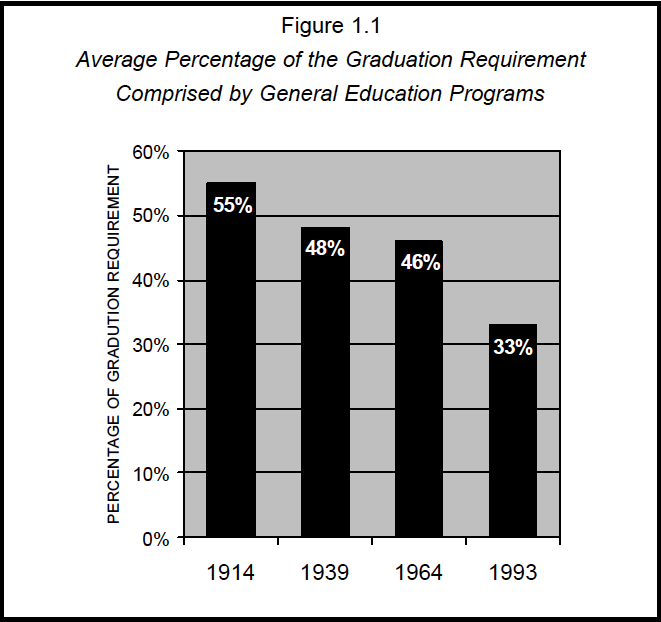
In 1914 an average of 55 percent of the credits necessary to earn a baccalaureate degree in arts at the institutions we studied had to be taken within the general education requirement. The figure decreased to 48 percent in 1939, to 46 percent in 1964, and to just 33 percent in 1993 (see Figure 1.1).
Exemption from General Education Requirement
Finding 2: General education’s progressive de-emphasis is even more marked when the possibilities of gaining exemptions from the stated requirements are taken into account. Between 1914 and 1993, the percentage of the general education requirement that students could not avoid fell from 98 percent to 29 percent (see Figure 1.2).
As the number and variety of fixed requirements have shrunk or disappeared, it has simultaneously become easier to avoid those that remain. To be sure, over the entire period studied many of the colleges and universities have permitted students to test-out or in other ways waive particular requirements, but these opportunities have become vastly more commonplace in recent years. As a result, students who can make a showing of college-level competence can now free themselves from taking a very substantial number of basic general education courses.
In 1914 exemptions were rarely granted, an average of 98 percent of the general education requirement not being subject to waivers. As Figure 1.2 indicates, that average had decreased to 85 percent in 1939, to 62 percent in 1964, and to 29 percent in 1993—less than half of the 1964 percentage. (In contemplating this data, keep in mind that the average percentage of the total graduation requirement devoted to general education declined by 28 percent between 1964 and 1993.)
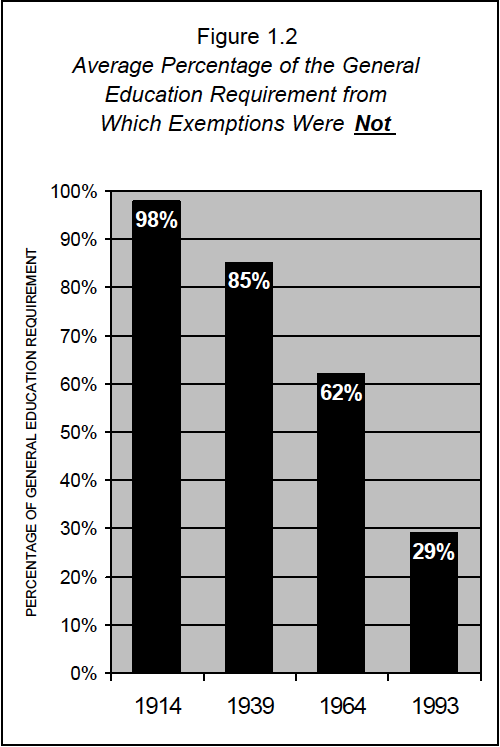
To be sure, exemptions can be academically justified. If a student demonstrates a college-level mastery of an academic subject, shouldn’t he or she be allowed to shorten the time spent in college or be encouraged to study other or more advanced subjects, instead of merely covering old ground? To the extent that exemptions open the door to more sophisticated course work rather then simply diminish the credits needed to graduate, it can be argued that it is better to allow them than not. On the other hand, it is certainly not self-evident that high test scores and completing an advanced placement course in high school represent quite the same thing as encountering a subject in a college classroom. This is probably most likely to be true in the “softer” domains of the humanities and the social sciences, where relatively brief answers to examination questions may not fully capture the quality of understanding that can flow from participation in a sophisticated course taught by a college or university faculty member, especially for those gifted students most likely to select advanced placement options.
Mandatory Courses
Finding 3: In 1993 the average percentage of the credits needed to graduate that students had to complete in mandatory courses (i.e., the “credit weight” of mandatory courses) was only about a third of what it had been in 1964 and only about a fifth of what it was in 1914 (see Figure 1.3).12
Even more revealing is the very steep decline in the number of general education courses that all students must complete. Such mandatory courses reflect an institutional decision that every graduate will be exposed to specific subject matter it considers to be fundamental, and represent the strongest level of commitment to ensuring that there is indeed a common core of learning. Figure 1.4 shows that in 1914, 65 percent of the credits needed to fulfill the general education requirements had to be earned in mandatory courses. In 1939 and 1964, this figure stood at 51 percent and 47 percent respectively. By 1993 it had tumbled to 21 percent.
This decline, of course, occurred alongside an accelerating contraction in the size of the general education requirement as a whole. Consequently, if reckoned as a percentage of the credits needed to fulfill the overall baccalaureate requirement, the decline in the proportion of credits constituted by mandatory courses is much greater than Figure 1.3 suggests, descending from 36 percent in 1914, to 24 percent in 1939, to 22 percent in 1964, and finally to a mere 7 percent in 1993 (see Figure 1.3).
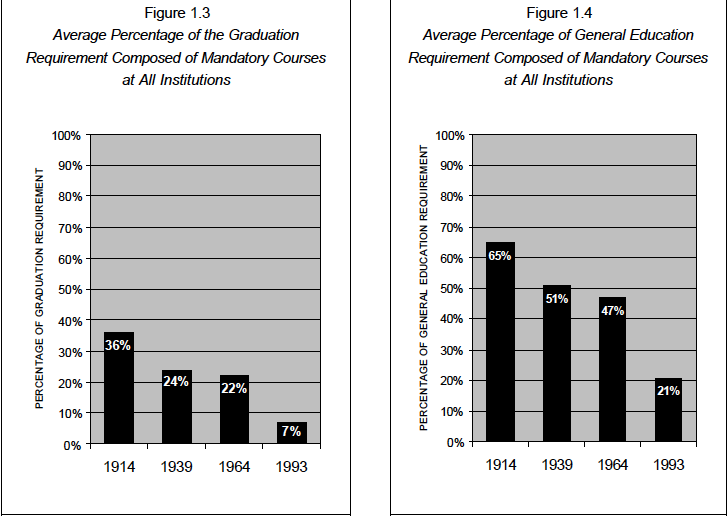
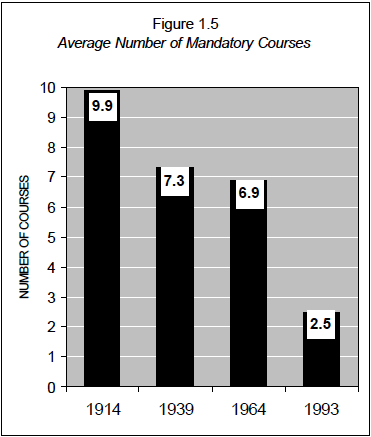
Another perspective on this trend is afforded by computing the average number of mandatory courses per institution. As Figure 1.5 shows, in 1914 students at the colleges and universities studied had to take an average of 9.9 mandatory courses. This figure stood at 7.3 in 1939 and 6.9 in 1964. By 1993 in had fallen to only 2.5 courses.
Course Clusters in the General Education Requirement
Finding 4: The average percentage of the credits needed to graduate that had to be taken in “preferred courses” (those located in clusters) remained well above 10 percent in 1914, 1939, and 1964. Between 1964 and 1993, however, “preferred courses” virtually disappeared from the catalogues (see Figure 1.7 on page 9).
Mandatory courses are not the only means by which a school can accord certain subjects special preference within the general education curriculum. As already noted, another common method is to group courses into clusters and require students to make one or more choices within them. For example, a cluster of three courses at Colby College in 1964 consisted of introductions to Western philosophy, moral philosophy, and logic; while a cluster of four courses at Mount Holyoke in the same year contained four introductory courses in economics, political science, psychology, or sociology. We call courses contained in such cluster “preferred courses.”
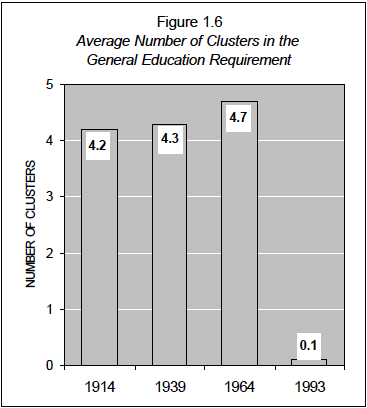
The pattern disclosed by the data in Figure 1.6 shows a slight increase in the incidence of clusters from 1914 to 1964 and then their near extinction as a feature of general education curricula after 1964. Thus, there were on average 4.2 clusters in the general education requirements in 1914, 4.3 in 1939, 4.7 in 1964, and 0.1 in 1993.
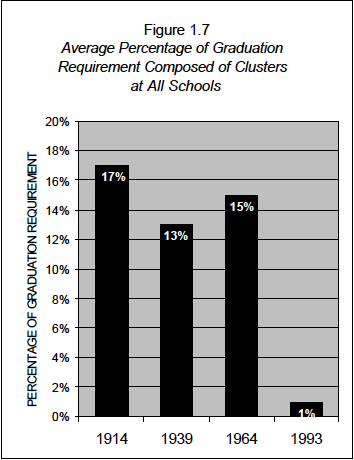
Examined in their relation to the total baccalaureate requirement, the average credit weight of clusters comprised 17 percent of the total credits needed to graduate in 1914. As Figure 1.7 shows, this figure fell to 13 percent in 1939 but increased to 15 percent in 1964. As of 1993, however, it had fallen to a minuscule 1 percent.
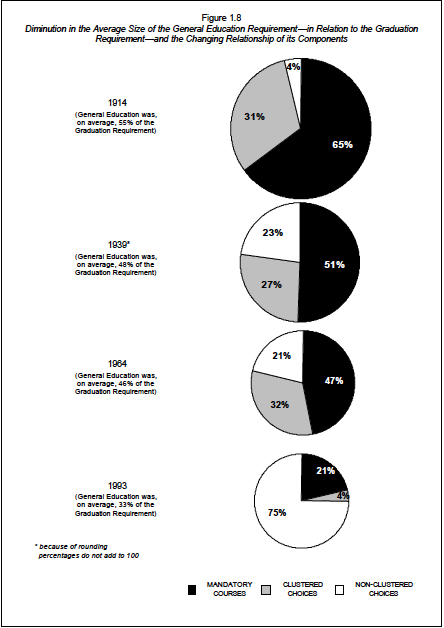
If the general education requirement during the years examined is represented as a pie a variety of trends becomes readily apparent: (1) the pie gets smaller with each passing quarter-century; (2) the slice of the pie represented by mandatory courses continually shrinks; (3) the slice of the pie represented by clusters peaks in 1964 but virtually vanishes by 1993; and (4) the segment devoted to non-clustered choices becomes proportionately larger until it consumes three-quarters of the substantially diminished pie (see Figure 1.8 on page 10).
The Number of Undergraduate Courses
Finding 5: The average number of undergraduate courses in the catalogue of each institution has increased by a factor of almost five since 1914 and almost doubled between 1964 and 1993. This trend has been especially pronounced in the humanities and social sciences.13
All the courses, in every catalogue, for each of the years studied were counted. Even by limiting the count to courses open only to undergraduates pursuing a bachelor’s degree—and eliminating cross-listed courses—the count spirals upward dramatically (see Figure 1.9 and 1.10).
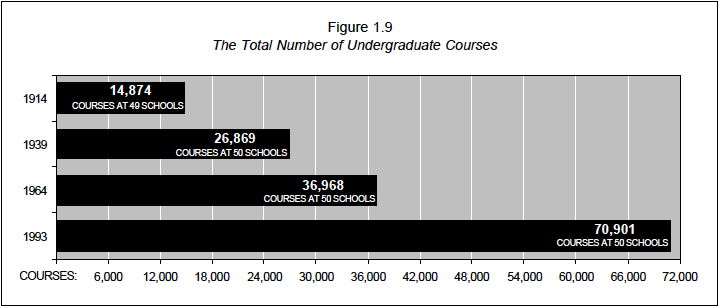
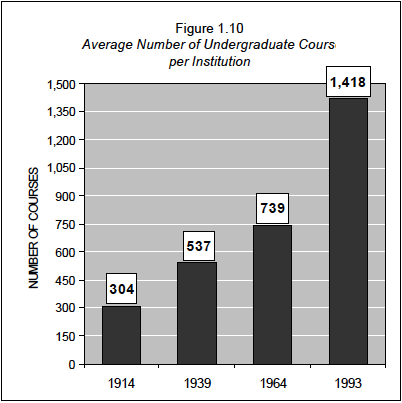
The magnitude of the increase in the average number of courses differs significantly among subject areas. Thus, as Figure 1.11 shows, over the total period studied the average number of humanities courses increased more then five-fold, the average number of social science courses increased almost nine-fold; but the average number of mathematics and natural science courses grew less than three-fold.
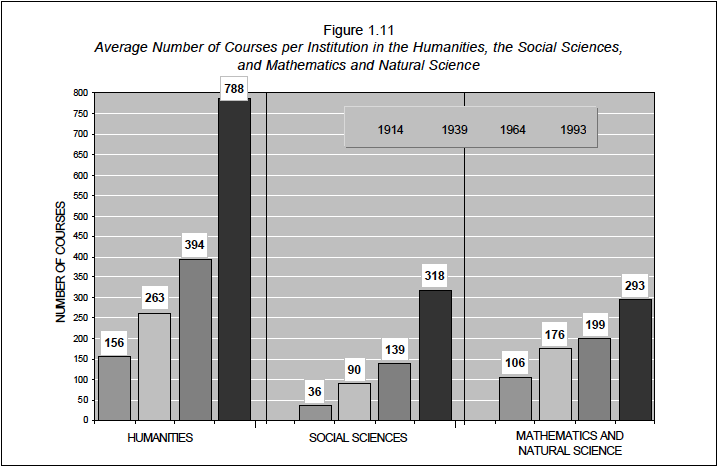
While the rate of growth in the number of courses between 1914 and 1939 was roughly comparable to that between 1964 and 1993, the increase in the absolute number of courses was much greater in the latter period. To illustrate how this affected the degree of choice available, assume an enrollment in thirty-two courses by the typical student fulfilling the baccalaureate requirement. Under this premise, in 1914 for every course to be taken there were approximately ten in the catalogue, as compared to about seventeen in 1939, and twenty-three in 1964. By 1993, however, there were on the average about forty-four courses for every course in the catalogue that could be taken.14
Of course, the degree of available choice is not a direct function of the number of courses listed. Both general education requirements—such as they are—and major subject requirements, together with the frequency with which courses are actually offered, put choice under a variety of constraints. Still, with broad distribution categories now the dominant feature of general education requirements, and a large portion of the baccalaureate requirement consigned to free electives, the very sizable number of courses currently in the catalogue has heightened consequence. And this is all the more true in light of the recent, sharp decline in the number of more specialized courses that require the successful completion of prerequisites as a condition for enrollment.
The Incidence of Course Prerequisites
Finding 6: The proportion of undergraduate courses without listed prerequisites began to rise after 1939, but remained less than 20 percent of the total number of courses through 1964. By 1993, however, courses without listed prerequisites composed 41 percent of all courses. This trend has been especially pronounced in the humanities and the social sciences (see Figure 1.12 and Figures 1.13 to 1.15 on pages 14-15).
If mandatory courses, clusters, and distribution requirements can be said to compose the gross structure of the curriculum, course prerequisites might well be thought of as its fine structure. On the premise that more advanced, specialized courses can only be understood, much less mastered, following the completion of introductory one, prerequisites operate to make the acquisition of knowledge cumulative and coherent. They also serve to limit enrollments in more specialized courses.15
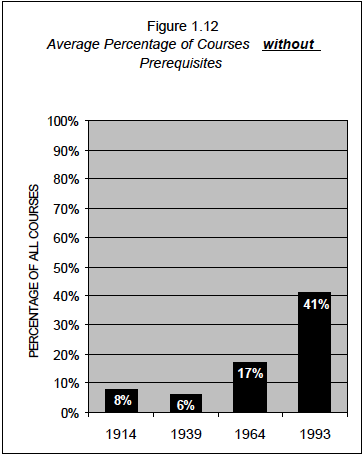
The data show some very obvious patterns. The majority of courses still carry listed prerequisites and many (notably mathematics and the natural sciences courses) may entail the completion of several, thereby creating tiered systems of instruction. However, prerequisites currently constrain far less of the curriculum than they once did and declined substantially in significance between 1964 and 1993. To a large extent, the figures speak for themselves. As Figure 1.12 shows, in 1914 only 8 percent of all the undergraduate courses at the institutions examined did not carry listed prerequisites. This figure fell to 6 percent in 1939. Over the next twenty-five years, however, a moderate increase set in bringing the 1964 figure to 17 percent. Thereafter, as with other trends we have described, the change was precipitous: by 1993, 41 percent of all undergraduate courses were without listed prerequisite.
As dramatic as these figures are, it is even more instructive to look at what they mean with respect to the growing number of courses available to academically inexperienced undergraduates. Thus, in 1914 the number of courses in which a student could enroll without completing any prerequisite averaged only 23 per institution. Though the percentage of prerequisites increased, the simultaneous growth in the overall number of courses available raised this figure to 34 courses by 1939. Then came the explosion. Between 1939 and 1964, the average number of courses without prerequisites more than tripled, rising to 127; and, between 1964 and 1993, they increased over fourfold to 582. Needless to savy, the overwhelming majority of courses without prerequisites were not surveys of basic subject matter or general introductions to the methods and theories of disciplines, but narrow, recondite, often idiosyncratic offerings, more apparently tailored to the scholarly interests of faculty than to any of the traditional priorities of undergraduate education. The following, drawn from a variety of 1993 catalogues, illustrate how specialized open courses can be:
English: “Arthurian Literature.” Survey of medieval classics (in translation) that recount the legends of Arthur and his companions. Focuses on the relation between history and fiction and on the social uses of literature, and on the construction of gender roles.16
History: “Russian Legal Institutions Before 1700.” This lecture course covers the following topics: the medieval Russkaia Pravda and its dyadic legal system; the Sudebniki of 1497, 1550, 1589, and 1606; the evolution of Russia from an oral to a documentary-based society; the Lithuanian Statutes of 1529, 1566, and 1588 and their impact on Russian law; the development of the central government and the evolutions [sic] of the chancellery system; the rise and fall of the Assembly of the Land; the use of Byzantine laws and the evolution of Russian church law; the Ulozhenie of 1649 and its supplements; and the evolution of provincial administration.17
Linguistics: “Mathematical Linguistics.” Introduction to topics in logic, set theory and modern algebra, with emphasis on linguistic application. Automata theory and the formal theory of grammar with special reference to transformational grammars. No previous mathematics assumed.18
As with the increase in the number of courses, the severe decline in the frequency of prerequisites has not occurred uniformly across subject areas. It has been predominantly concentrated in the humanities and social sciences. The pattern is quite interesting.
In the first three years we examined, the differences in the relative percentages of courses with prerequisites from area to area were relatively small (see Figure 1.13 below and Figures 1.14 and 1.15 on page 15). By 1993 they had become considerably greater. Thus, while 79 percent of all natural science courses still had prerequisites, only 53 percent of humanities courses and 56 percent of social science courses had them.
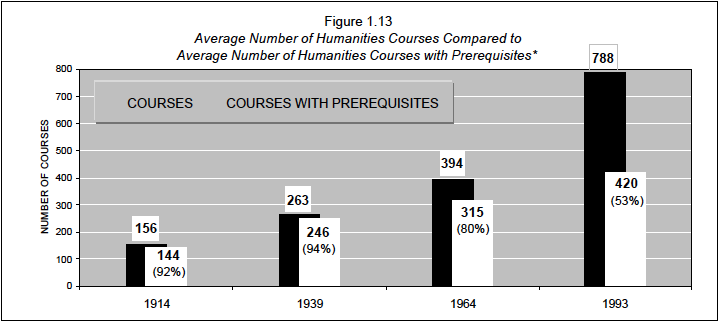
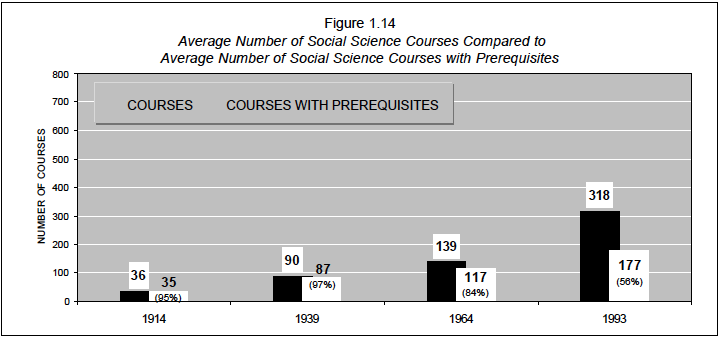
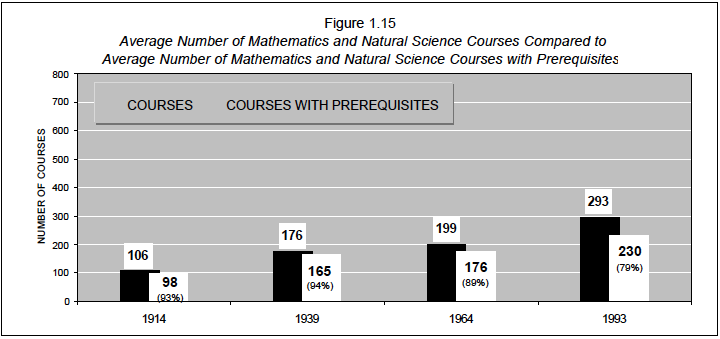
The contrasts become even more vivid when we translate these percentages into the average number of courses available to the beginning student (i.e., one who has not completed any prerequisites). Figure 1.16 on page 16 shows that in 1914 these averaged 12 courses per institution in the humanities, 2 courses in the social sciences, and 8 courses in mathematics and natural science, figures that had changed little by 1939. By 1964, however, these numbers rose to an average of 79 in the humanities, 22 in the social sciences, and 23 in the natural sciences. By 1993 the numbers were 369 in the humanities, 141 in the social sciences, and 63 in mathematics and the natural sciences. Put another way, the ratio between the average number of natural science courses without prerequisites and the average number of humanities courses without prerequisites stood at less than one-to-two in 1914 and 1939, under one-to-four by 1964, and almost one-to-six by 1993.
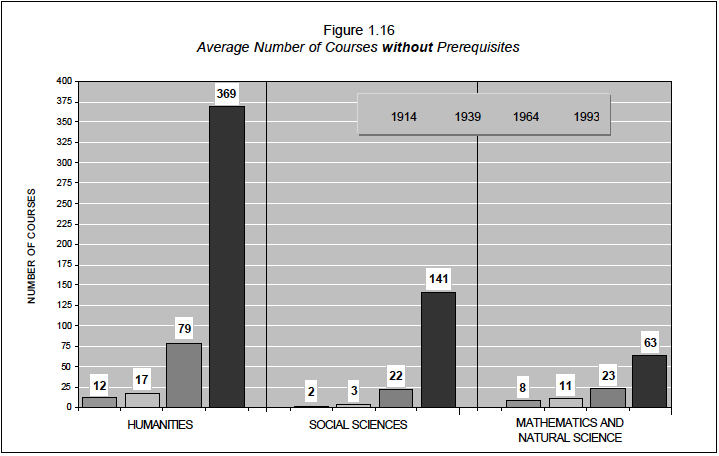
These inter-subject contrasts are rather paradoxical. While both the social sciences and the humanities have recently sought to become more like the natural sciences in many of their claims and methods, they bear less and less resemblance to the natural sciences with respect to the structure of their curricula, at least insofar as they present themselves in programs of undergraduate instruction. Thus, in the post-World War II era, a “behavioral revolution” left the social sciences far more empirical, quantitative, and methodologically self-conscious than they had been earlier. Since the 1970s, the humanities have also been systematically reshaped by the rise of a legion of new interpretive perspectives claiming the status of “theory,” leading prominent figures repeatedly to take pride in a supposed substantial expansion of “new knowledge.” Yet in mathematics and the natural sciences, where the expansion of new knowledge, theory, and specialization has undoubtedly been revolutionary, the growth in course offerings has been very much slower. Furthermore, mathematics and the natural sciences, through their prerequisite systems, have retained a graduated system of instruction—moving from the general to the specialized—which the humanities and social sciences have increasingly abandoned. Obviously, the mammoth and undeniable amounts of new knowledge and theory in mathematics and the natural sciences have somehow proved consistent with a smaller and more economical curricular frame. Whatever has actually been happening in the humanities (and to a lesser extent in the social sciences), the outcome has been remarkably otherwise.
Time Frame for Completion of General Education Requirement
Finding 7: As the size of the general education requirement has decrease d, the period of time allowed for its completion has expanded (see Figure 1.17).
Colleges and universities sometimes place time limits on the completion of some or all of their general education requirement. The reasoning behind this policy rests on two premises: first, that the eventual choice of a specialized field is best based on a prior exposure to a range of subjects and, second, that students are better positioned to acquire specialized knowledge when they already possess a broad intellectual framework within which to place it. In effect, then, time restrictions perform a function similar to prerequisites, providing a pedagogical order to the sequence of instruction.
Time constraints on the completion of the general education requirement typically involve setting deadlines for completing part or all of the requirement. Hence, another way to assess the changing degree of structure in the general education requirement is to calculate the number of schools that set time limits during the years studied.
Figure 1.17 shows that time restrictions were at their peak in 1939, when 78 percent of the institutions examined demanded that students complete the general education requirement before the end of their sophomore year. By 1964, however, the number of institutions imposing such a restriction shrank to 42 percent, and by 1993 this figure dropped to 26 percent.
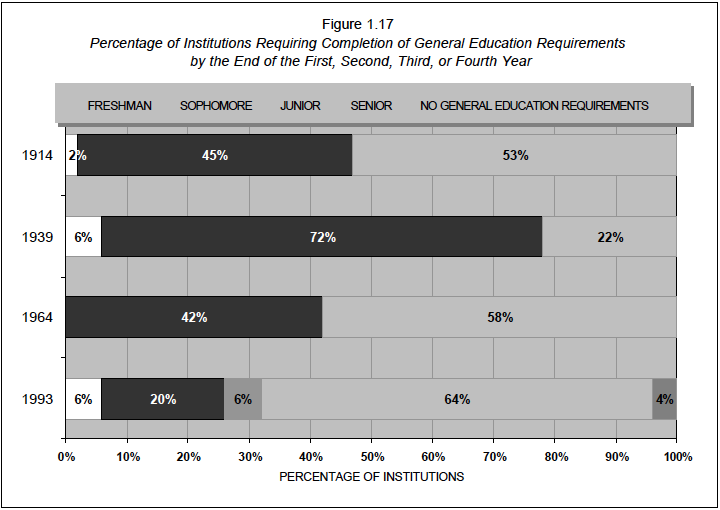
Chapter II
The Evaporation of Content
We expect that each new generation of Americans will go into the world with a substantial store of general knowledge about our society. Even more, we hope that this will be true of our country’s future leaders. Doubts on this score should be as discomforting as any we might entertain about the adequacy of the nation’s defenses. Indeed, a common line of argument in justifying the government’s education expenditure has been that the security of America’s institutions depends as much on its academic as on its military investment.
Our leaders in the first instance, and our citizens ultimately, serve as the guardians of America’s liberal heritage. But, as a passing glance at the world reveals, our traditions are still exceptional, embodied in ideals, attitudes, and practices that are complex and difficult to master. Their preservation—to say nothing of the possibility for their further growth and refinement—depends greatly on the fund of knowledge our leaders and politically active citizens possess.
This knowledge should embrace the history and operation of our political, economic, and cultural institutions, to say nothing of the evolution of the seminal ideas and movements that have sustained or challenged them. Moreover, we would expect that the grasp of these subjects should be more than schematic, containing a fairly sophisticated appreciation of the texture of events, the interplay of ideas, and the varied possibilities of human action. Since formative ideas and cultural sensibilities are often most profoundly explored or reflected in great creative works, we should also wish a rising generation of leaders to acquire some substantial familiarity with (and, optimally, appreciation for) the major achievements of their culture and civilization in literature, music, and the visual arts.
Nothing has shaped the modern world more than the natural sciences and the protean technologies they have generated. Apart from standing as the most rigorous expressions of human thought, their mastery is critical to an understanding of innumerable issues of public policy and intellectual dispute. While scientists and engineers comprise only a minority of the country’s educated people, leadership in all sectors of society, and most particularly that within the political and cultural realms, should understand the reach, development, and limitations of scientific analysis for the policies over which they have responsibility, or which they address in debate. This requires, among other things, a comprehension of science as method and process, and not merely as a body of knowledge or as an oracular source of theoretical authority.
It has become axiomatic among educators that America now faces the daunting challenge of preparing for participation in an increasingly diverse world community in which political and economic power, to say nothing of cultural influence, is more widespread than ever before. One can quite plausibly argue, of course, that the lineaments of the global society now emerging are, for the most part, Western (and even Anglo-American) in origin and likely to remain so for the foreseeable future—recommending more instead of less study of specifically Western (or Anglo-American) culture. Nonetheless, to the very real extent to which the knowledge of other cultures and civilizations is important, training in foreign languages is a very significant point of entry. Beyond language instruction, the study of the history, politics, literature, and philosophy of other cultures is also of obvious importance, provided that it is attempted seriously and conducted in as critical a manner as is the study of our own society.
This overview of what we desire our citizens and, most especially, our leaders to know represents a starting point for evaluating the changing content of the general education curriculum. It does not by any means require the anointment of one curricular formula, but it certainly recommends an exposure of some breadth to history, literature, philosophy, politics, economics, mathematics, and the natural sciences, as well as the development of competence in at least one foreign language. If our elite colleges and universities best serve the country when they provide such broad exposure, a close review of the changing content of general education requirements accords a fair reckoning of how well they have met the mark.
To be sure, broad introductions to these subjects can be adequately provided prior to university entry, especially if expectations are not extremely high. Since many of our citizens will not receive any postsecondary instruction in the liberal arts, general education must be a major priority of our high schools. Indeed, in some other countries, where university instruction is usually confined to a relatively small student elite, higher education programs are very specialized, assuming the mastery of general subjects at the preparatory level. This, however, has never been the American approach and would be much less appropriate to our more egalitarian vision of higher education’s purpose. In addition, the signs of decline over the last quarter century in the level of preparation among students graduating from American high schools, compounded by the increasing willingness of even elite schools to admit students in significant need of remediation, argue more strongly than ever for serious collegiate attention to ensuring that programs in general studies cover basic subject matter.
The structure of a general education program has a major and inescapable influence on its content. For one thing, an unstructured general education program often allows the student to bypass major areas of subject matter entirely. For another, in choosing to take a course within a given field (particularly in the absence of prerequisites), a student may select a narrow, recondite topic instead of a broader survey. For well-prepared undergraduates such elections may be wise. For many others, however, they are likely to prove educationally disastrous. But whatever the case, the direction of a student’s choices will have much to do with the level of structural constraint the curriculum provides.
In this chapter we look specifically at the subject content of general education programs in 1914, 1939, 1964, and 1993 for the schools examined, asking what kinds of courses students were obliged or encouraged to take by virtue of the catalogue requirements. This entails examining the frequency with which individual courses or subjects were required or in some other way given special emphasis, and the changes in the percentage of the general education programs (and baccalaureate programs) constituted of such requirements.
The result of this assessment of changes in content is as dramatic as the result of that already conducted with respect to changes in structure, especially from 1964 to 1993. Thus, while the half-century between 1914 and 1964 saw a gradual, though irregular, decline in the number of survey courses that students were required or strongly encouraged to take, the post-1964 period witnessed their near elimination as requirements. A generation will pass before American society feels the full impact of this vast de-emphasis of general knowledge.
To document these changes fully, we will examine the content of the general education curriculum by looking at a variety of important subjects and asking:
1. Were there introductory courses that were required in that subject for all baccalaureate students?
Such mandatory courses represent the maximum degree of constraint an institution can impose and are a key indicator of the degree to which a curriculum guarantees a broad introduction to subjects in a variety of fields.
2. In the absence of mandatory courses, were there single-subject clusters within which the student was compelled to select one of a small number of basic courses in that subject?
The single-subject cluster is the second most frequently employed curricular device for institutions seeking to constrain student choice and ensure that they take basic courses in particular subjects. It allows a school to provide some latitude in course selection while ensuring that the courses taken remain of a general nature. In history, for example, this approach might allow election among introductory courses in Western, American, or world history or in literature between an introductory course in English literature and one in comparative literature.
To review the extent to which such restricted choices were used in general education programs, we counted each instance, at each school, over the eighty-year period studied, in which students were required to choose a course from a single -subject cluster. Our premise, almost invariably born out by inspection of the courses typically found in such groupings, was that this degree of constraint was close to a guarantee that the offering finally selected would neither be narrow, idiosyncratic, or especially advanced.
3. In the absence of required single-subject clusters, were there individual courses that, given the catalogue requirements (and assuming that students chose randomly), had between a one-in-two and one-in-six chance of being taken?
As with courses found in single -subject clusters, the courses in what we call “multi-subject clusters” (e.g., a three-course cluster in which a student could choose among a history, a literature, or a philosophy course) were generally of a broad introductory nature. The prevalence of these multi-subject clusters in the catalogue therefore stands as a third indicator, albeit a somewhat weaker one, of a school’s effort to ensure students a broad exposure to basic subject matter.
4. In the absence of mandatory courses or clusters of any type, were there still categorical requirements that compelled students to take at least onecourse within a specific subject area?
Though such categorical requirements may often be satisfied by taking rather specialized courses, they are at least narrower—by virtue of their restricted subject focus—than the broad multi-subject distribution categories that now dominate catalogues. In order to analyze the changing prevalence of these requirements, we counted their incidence in composition, foreign language, literature (in English), rhetoric, history, fine arts, philosophy, religion, economics, physical education and hygiene, political science, psychology, sociology, mathematics, biology, chemistry, and physics for each of the years reviewed. Subject by subject the results are as follows:
English Composition
There remains a strong consensus on the place of composition courses in the general education curriculum, no doubt because the skills they impart are central to the successful completion of all other subjects. Nonetheless:
Finding 8: Although there was little change in the incidence of required composition in the first twenty-five years covered by our study, and only a small decline between 1939 and 1964, between 1964 and 1993 the percentage of schools requiring students to take a course in composition—administered by the English Department—declined from 86 to 36 percent (see Figure 2.1).
Figure 2.1 shows the slight decline in the percentage of schools having composition or specific writing courses between 1914 and 1964 and the larger drop afterwards. (It should be noted, however—as Figure 2.1 also shows—that if we expand the definition of a composition requirement to include one that requires students to choose from a scattering of courses in other subjects, described as demanding writing proficiency, the percentage of institutions with some form of writing requirement shows significantly less decline.)
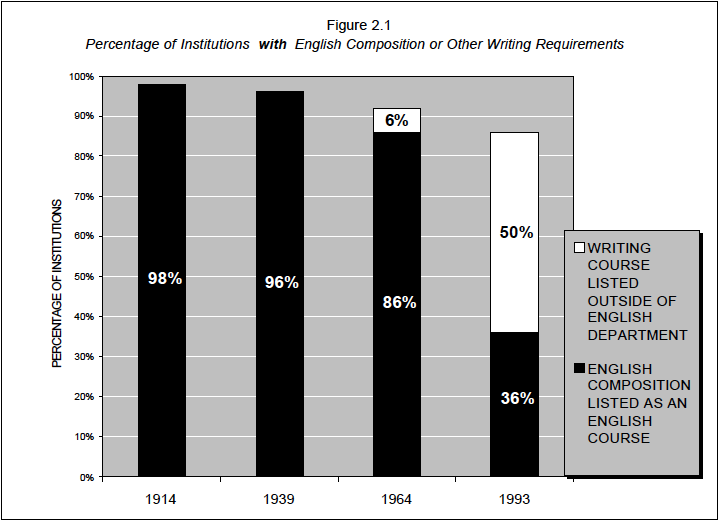
As Figure 2.2 shows, when the average credit weight of the composition and writing courses at the institutions offering them is compared over the same period a very similar pattern emerges. From 1914 to 1964, the proportion of the baccalaureate requirement constituted by composition and writing courses held fairly constant, but, between 1964 and 1993, it shrank considerably.
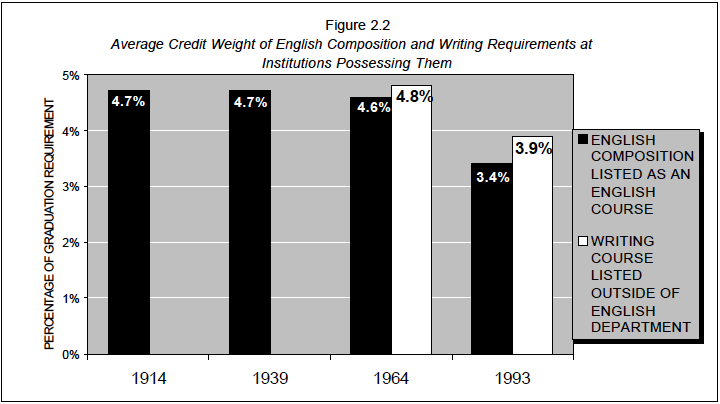
Rhetoric
Along with grammar and logic, rhetoric—the skill of using words effectively in speech and writing—forms part of the traditional liberal arts trivium. Like composition, it has significant utility for the successful completion of other college subjects as well as for success after college.
Finding 9: Rhetoric, as a distinct general education requirement, was found at one-third of all schools in 1914 (although it was a component of over two-thirds of the mandatory composition courses). By 1993 these requirements had entirely disappeared, though a rhetoric component existed within a regular English composition course at two (4 percent) of the institutions (see Figure 2.3 on page 24).
Figure 2.3 on page 24 shows the decline in specific required rhetoric courses from 1914 to 1964 and their subsequent disappearance. Figure 2.4, also on page 24, shows the change in rhetoric’s average credit weight within the graduation requirement.<19
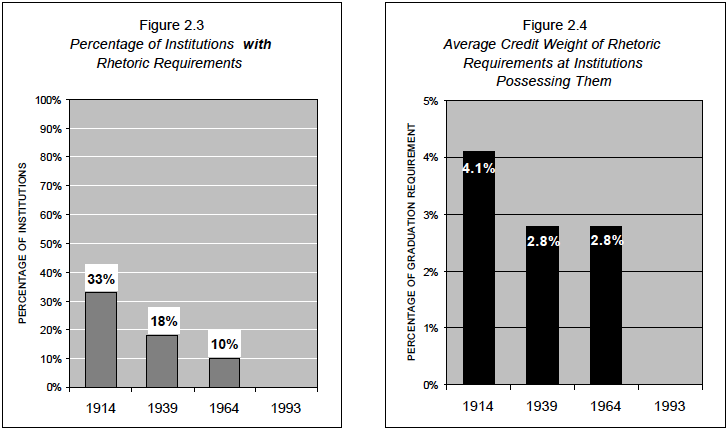
Foreign Language
In addition to fostering the ability to handle English competently, some capability in at least one foreign language has also been a common goal of general education programs. Nonetheless, the degree of consensus about the necessity of a foreign language requirement has significantly diminished among the schools we examined.
Finding 10: In 1914, 1939, and 1964, at least 90 percent of the institutions had mandatory foreign language requirements. By 1993 slightly less than two-thirds retained them (see Figure 2.5 on page 25). Moreover, the percentage of the overall graduation requirement composed of foreign languages had—on average—declined at the schools retaining them, sharply between 1914 and 1939 and more moderately after that (see Figure 2.6 also on page 25). Nonetheless, the number of foreign languages available to satisfy the language requirement rose steadily, almost doubling between 1964 and 1993.
On page 25, Figure 2.5 shows that the number of institutions with foreign language requirements held roughly steady between 1914 and 1964. A somewhat different pattern with respect to the average credit weight of the foreign language requirement emerges from Figure 2.6, also on page 25, which shows that it shrank by about a quarter between 1914 and 1939 and by about two-fifths between 1914 and 1993.
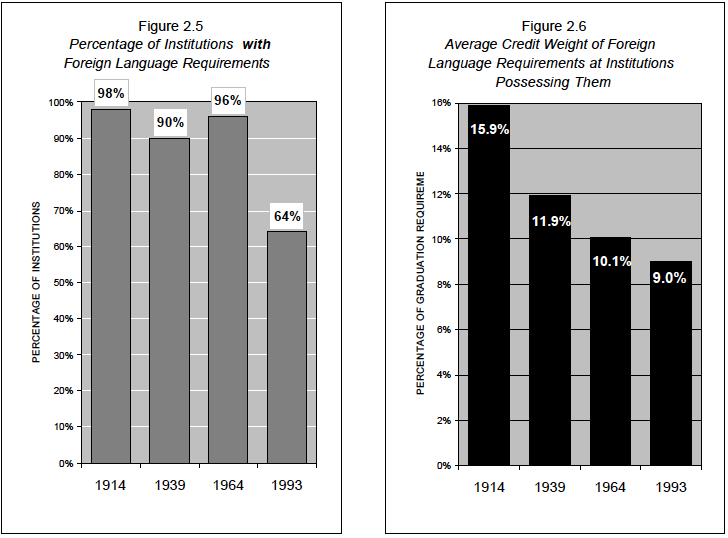
To be sure, there are now far more foreign languages taught at the colleges and universities examined that can fulfill the general education requirements. In 1914 there were just four offered on average. By contrast, there were on average more than thirteen languages to choose from in 1993.
There was also a change in the character of the languages available for study. For instance, in 1914 thirty-nine (80 percent) of the schools demanded that at least part of their language requirement be fulfilled through the study of classical Latin and/or Greek. By 1939 only nine schools (18 percent) still required Latin or Greek; and by 1964 these requirements had entirely disappeared. Moreover, while in 1914 none of the institutions offered the possibility of studying a non-European language as part of their general education program, in 1993, 29 percent did.
Despite the wider range of languages available, there does seem to be a notable discrepancy between the emphasis placed on “multiculturalizing” the curriculum and the decline in foreign language requirements. After all, if there is a necessary condition for becoming deeply knowledgeable about another culture, it is the mastery of its language. Given the stated aim of the multicultural movement, it is especially puzzling that the need to restore or strengthen foreign language requirements is generally absent from its rhetoric and the proposals for curriculum change made in its name.
Other Humanities Requirements
None of the other standard humanities subjects—literature, history, philosophy, religion, and fine arts—has ever held the same commanding position within the general education requirement that composition and foreign language have enjoyed. Except in the case of literature in 1914, none of these subjects were specifically required at a majority of our schools during any of the years examined.
To be sure, through 1964 a sizable minority of the college and university catalogues examined did have specific requirements in these subjects. In fact, a significant number had mandatory courses or single-subject clusters in these areas. Yet the most common way of according priority to introductory courses in these fields was to place them in a multi-subject cluster. Thus, an English literature survey course might be grouped with an English history survey course; or, an introductory course in art history, music, or drama might be similarly clustered, allowing the student a three-fold choice. When the prevalence of all the devices (i.e., mandatory courses, single -subject clusters, and multi-subject clusters) for giving introductory courses special curricular status is collectively assessed, the historical trend is striking.
Finding 11: The general education requirements at a majority of the schools accorded some form of special curricular status (i.e., mandatory, single-subject, and/or multi-subject course groupings) to introductory courses in literature and history through 1964. In the case of philosophy, a majority did so in 1914, and a very large minority of schools in 1939 and 1964. By contrast, in 1993 none gave any special preferment to courses in literature, and only a handful did so in history or philosophy. In the case of religion and fine arts (music, theatre, etc.), a substantial minority accorded some special curricular status in 1914, 1939, and 1964, but none did in 1993 (see Figure 2.7).20
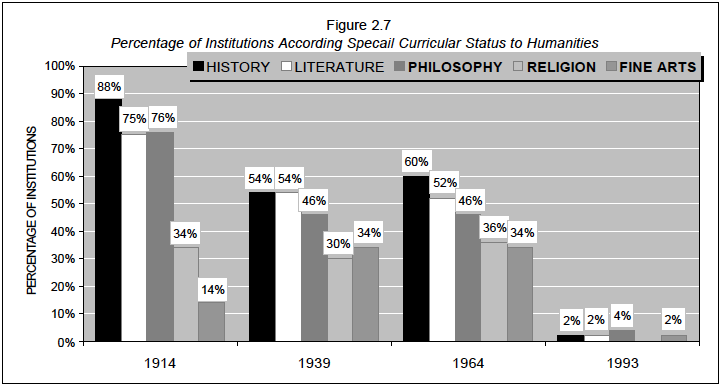
One should remain aware that an institution can accord a course in a given subject special curricular status, as we’ve defined it, without specifically requiring that subject. This can happen if the said course is part of a multi-subject cluster.
Let us now consider how introductory history, literature, philosophy, and religion courses have fared in greater detail:
History
Finding 12: While the percentage of institutions with specific history requirements has fluctuated considerably over the course of the century, it dropped from 38 to 12 percent between 1964 and 1993 (see Figure 2.8). Moreover, while the average credit weight of the history requirement rose between 1914 and 1964, it dropped by about two-fifths between 1964 and 1993 (see Figure 2.9).
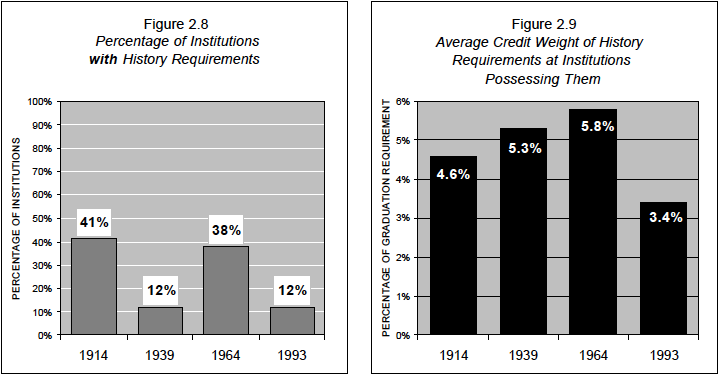
Finding 13: In 1914 almost 90 percent of the institutions accorded some sort of special curricular status in their general education programs to introductory history courses. In both 1939 and 1964, more than 50 percent did so. As of 1993, however, only one school did (see Figure 2.10 on page 28).
Figure 2.10 on the following page shows the percentage of schools that accorded special status to an introductory history course, either by making one course mandatory, by placing several in a single -subject cluster, or by making one history course an option in a multi-subject cluster, the last being the most common means of so doing.
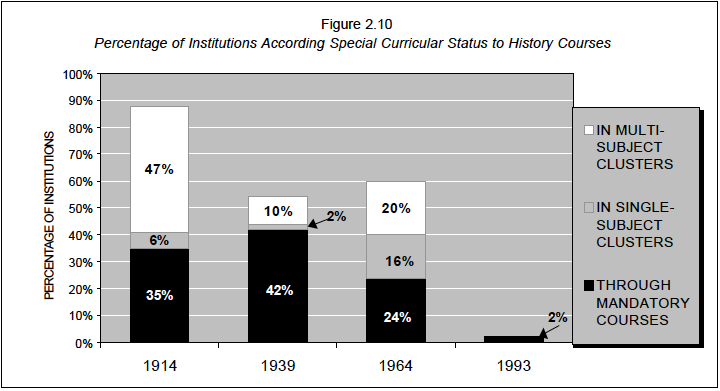
Since the years following 1964 witnessed the almost complete disappearance of mandatory and preferred history courses, it might be illuminating to review briefly the titles of mandatory or preferred courses in that year. No other procedure is as likely to provide a better grasp on the nature of the content that was subsequently lost.
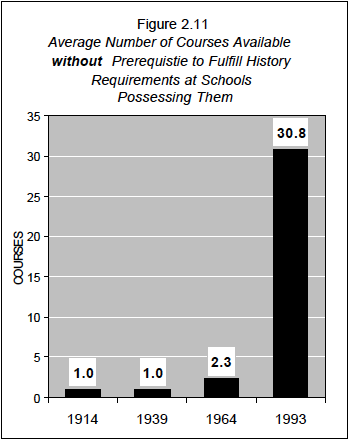
Twenty-eight schools had mandatory and preferred survey courses in Western or European history is 1964; only one had such a course in 1993. Sixteen institutions had mandatory or preferred survey courses in American history in 1964, none in 1993. Five schools had survey courses in ancient history, four had them in medieval history, two had them in English history, and one had such a course in the history of the Americas that enjoyed preferred status in 1964. In 1993 there were no mandatory or preferred courses in any of these subjects at the institutions studied.
It should be kept in mind that the presence of a history requirement does not mean that introductory courses have been given any special priority. This certainly was the case in 1993, when there were, on average, almost 31 history courses that could be taken without prerequisite at the schools that had history requirements—a tremendous increase over that figure in the earlier years (see Figure 2.11).
Literature
Finding 14: From 1914 to 1939, the percentage of institutions with literature requirements fell from 57 percent to 38 percent and remained at that level in 1964. By 1993, however, only 14 percent (seven institutions) had such requirements (see Figure 2.12). The weight of these requirements also diminished steadily. By 1993 the average credit weight was three-fifths of what it had been in 1914, and about three-quarters of what it had been in 1964 (see Figure 2.13).
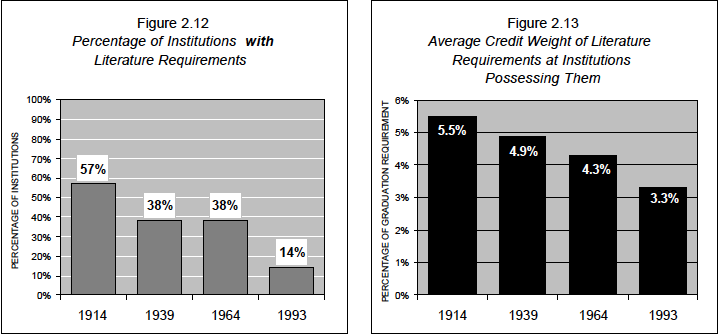
Finding 15: In 1914 more than two-thirds of the institutions accorded some sort of special curricular status in their general education programs to survey literature courses in English. This figure was still above 50 percent in 1939 and 1964. by 1993 preferred literature courses had vanished (see Figure 2.14)
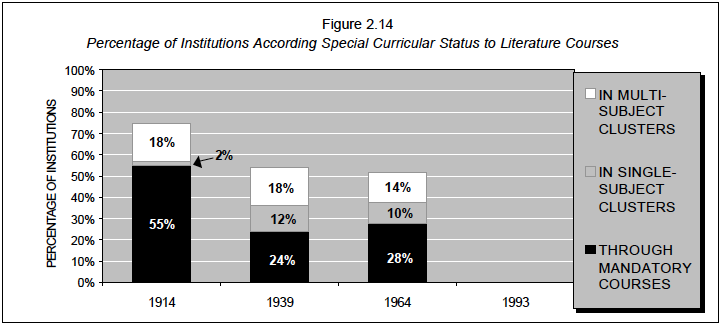
As in the case of history, it is instructive to take a more detailed look at the content of the literature courses that lost their special curricular status between 1964 and 1993. While twenty-six (52 percent) of our institutions had at least one such special survey course in English (or American) literature in 1964, none had such a course in 1993. While eight institutions had at least one such course in comparative literature (foreign literature in English translation) in 1964, none had such a course in 1993.
The great increase in the average number of courses available without prerequisites within 1993 literature requirements is shown in Figure 2.15. As we saw with respect to the average number of history courses available without prerequisites, the 1939 literature average remains about the same in 1914 and 1939. (The fractional figures reflect the once standard practice of prescribing the completion of English composition as a prerequisite for enrollment in any literature class. This practice was largely abandoned by 1964.) Between 1964 and 1993, the number of courses available without prerequisites increased about 24-fold.
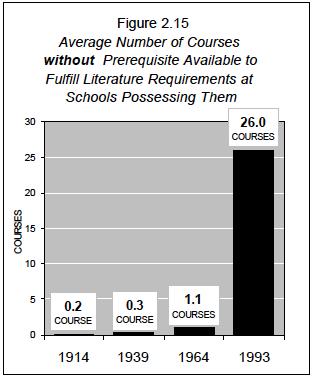
Philosophy
Finding 16: In 1914, 43 percent of the institutions had philosophy requirements. This figure dropped to 18 percent in 1939, stayed there in 1964, and fell to 10 percent by 1993 (see Figure 2.16). The average credit weight of the philosophy requirement, in schools where it existed, peaked in 1939 and then shrank by more than two-fifths between 1939 and 1993 (see Figure 2.17).
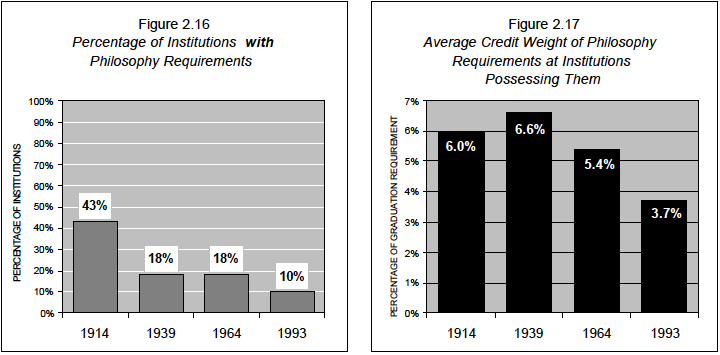
Finding 17: In 1914 more than two-thirds of the institutions accorded special weight in their general education programs to at least one introductory philosophy course. In both 1939 and 1964, slightly less than half did so. In 1993, however, only two institutions (4 percent) accorded any preferred status to a course in philosophy (see Figure 2.18).
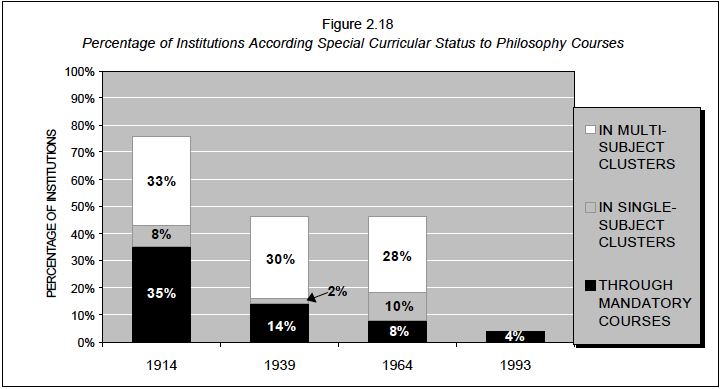
What kinds of introductory philosophy courses lost their special status between 1964 and 1993? General introduction to philosophy courses with some type of special status were found at fifteen schools in 1964, but at only two in 1993. History of philosophy courses had special status at six institutions in 1964, at none in 1993. Introductory logic courses were given special status at fourteen institutions in 1964, but at none in 1993. Courses in ethics were in the catalogues of five institutions in 1964, but in only one in 1993.21 In addition, in 1964 two schools had courses enjoying special status in aesthetics, one in epistemology, two in metaphysics, one on Plato, three in the philosophy of science, and eight on a variety of other philosophy topics. No courses in these categories had special status as of 1993.
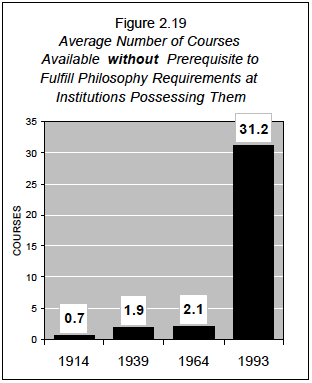
It might also be noted that, as with the case of literature and history, the average number of philosophy courses available without prerequisite rose very considerably from 1964 to 1993 (see Figure 2.19).
Religion
Finding 18: Religion has been a required subject at only a small—and generally declining—number of institutions (see Figure 2.20). The average credit weight of the religion requirement peaked at 5.8 percent of the graduation requirement in 1964. In 1993 it had shrunk by about a quarter (see Figure 2.21).
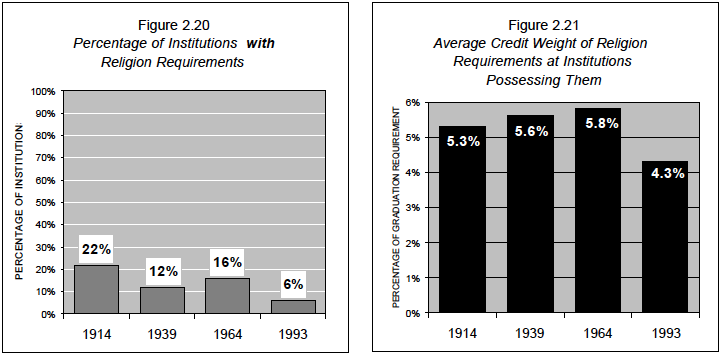
Finding 19: At least 30 percent of all colleges and universities accorded some form of special curricular status to courses in religion in 1914, 1939, and 1964. However, as Figure 2.22 shows, none did in 1993.
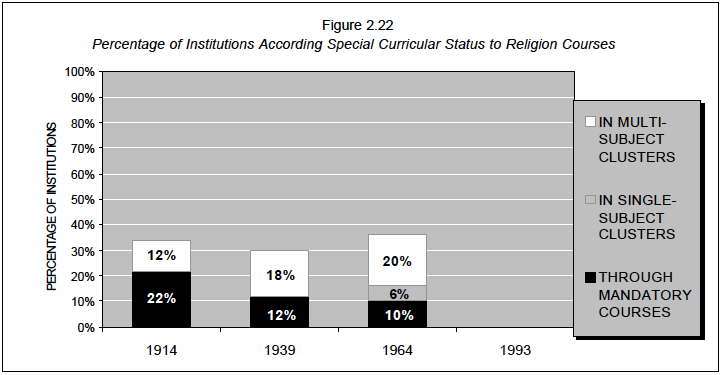
It should be noted that all institutions that required religion in the general education curriculum made at least one religion course mandatory in 1914 and 1939. By 1964 this figure had fallen to five of the eight schools with religion requirements.22
Social Science Requirements
Finding 20: Introductory courses in the social sciences that enjoyed a special curricular status were found at a majority of the institutions through 1964. By 1993 they had disappeared (see Figure 2.23).
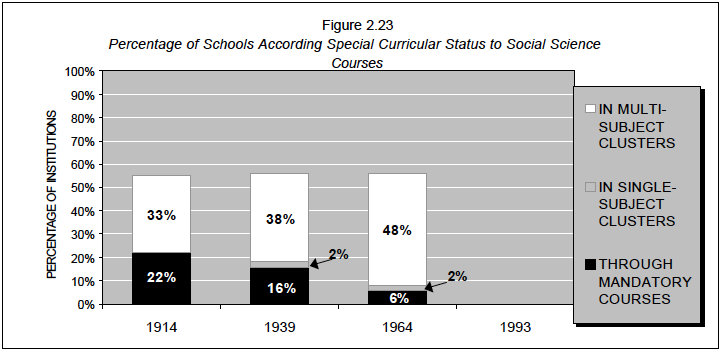
Looking at specific subjects within the social sciences, we find that in 1914 the greatest emphasis was given to economics. In 1939 political science almost equaled economics in importance, with psychology and sociology trailing shortly behind (see Figure 2.24, and Figures 2.25 to 2.27 on page 34). Nineteen sixty-four was the peak year for political science, psychology, and sociology, and all four subjects were nearly equally important. As of 1993, however, not a single institution in our study accorded special curricular status to a particular course in any of the fields.
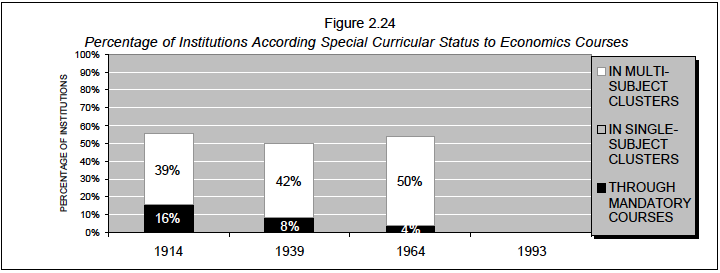
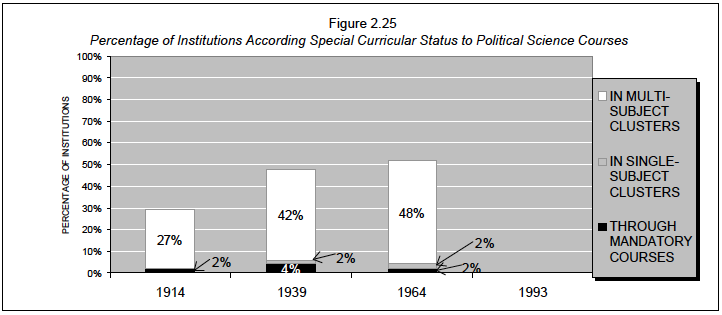
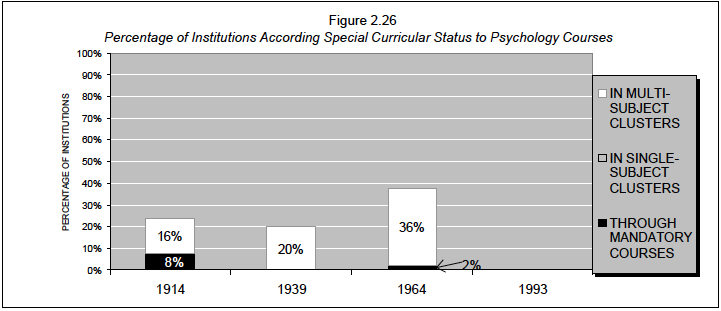

Integrated “General Education” Courses
The idea of requiring undergraduates to take a series of courses integrating a variety of humanistic, social, and natural science perspectives originated in the years immediately following the First World War. Pioneered by Columbia University and the University of Chicago, these team-taught, interdisciplinary programs sought to provide students with an overview of the development of Western Civilization and/or an opportunity to grapple with political and social issues of central importance to its modern predicament. In embracing the concept of a broadly based education for citizenship, they embodied a commitment to a liberal education in the original sense of that term.
Finding 21: The percentage of schools having integrated “general education” course requirements more than doubled between 1939 and 1964. By 1993 this percentage was about two-fifths as large as it had been in 1964. While in none of the years examined were such courses found at more than 26 percent of the institutions, where found, they composed, on the average, a much larger percentage of the baccalaureate requirement than did any other general education subject requirement (see Figures 2.28 and 2.29).
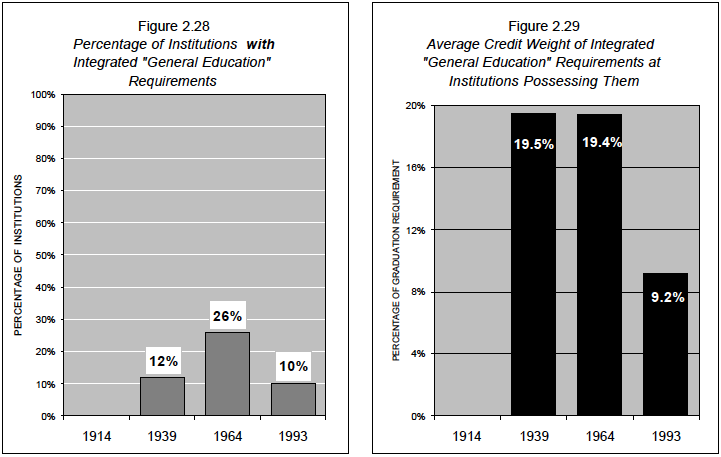
Natural Science and Mathematics
If contemporary civilization has one hallmark, distinguishing it from all previous times and cultures, it is the spectacular success it has achieved in developing a theoretical understanding and practical control of natural phenomena. The project of science and the protean efforts to give application to its findings are thus in very large measure what modernity is all about. What’s more, the importance and impact of science on the day-to-day quality of life, as well as on the course of public policy, continue to increase.
Leaders and citizens, whatever walks of life they may enter, need to understand the nature of scientific inquiry and have a general appreciation of the body of knowledge science has produced. They need to know this both to sharpen their own powers of thought and to comprehend the reach and limitations of rigorous observational and analytic methods. Such a comprehension also requires some familiarity with science’s demanding handmaiden—mathematics. Consequently, we would expect a solid general education program to include a serious and sustained introduction to science and mathematics.
Turning to the data, we might well anticipate that as the century progressed, and as the impact of scientific knowledge became ever more apparent, the commitment to providing a substantial education in the natural sciences and mathematics would have steadily deepened. What we find, in fact, is the opposite.
Finding 22: In 1914, 1939, and 1964, more than 70 percent of the institutions analyzed required students to complete at least one course in the natural sciences. In 1993 only 34 percent did so (see Figure 2.30). Mandatory mathematics requirements were found at only 12 percent of the schools in 1993, also a low for the period studied (see Figure 2.31).
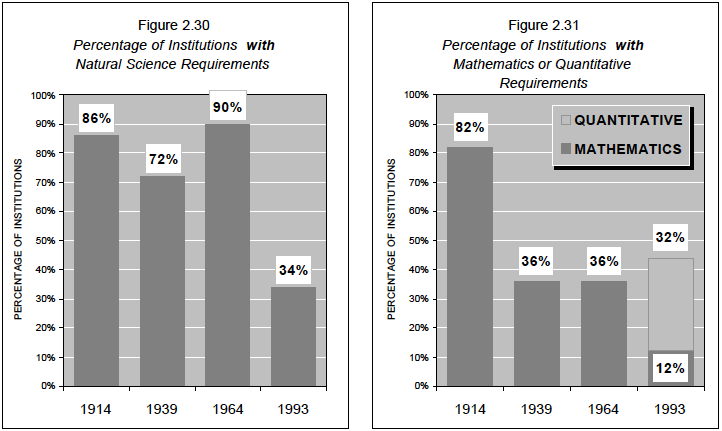
Figure 2.30 on page 36 displays the percentage of schools with requirements that can be fulfilled only by taking courses in the natural sciences. Figure 2.31 also on page 36 displays the percentage with specific mathematics requirements. It should be noted that, while only 12 percent of the schools in the study had traditional mathematics requirements in 1993, another 32 percent had introduced quasi-mathematical requirements that included “quantitative” courses taught outside the math department in lieu of traditional mathematics courses.23
It is also interesting to look at the changes in the number of institutions taking the most challenging path by demanding the completion of both mathematics and natural science courses. Not surprisingly, the change in the incidence of such a double requirement follows a pattern similar to that for the mathematics requirements taken alone—a sharp drop between 1914 and 1939, little change between 1939 and 1964, and a substantial decline form 1964 to 1993 (see Figure 2.32). By contrast, the number of schools with neither a mathematics nor a science requirement, though always small, reached its peak of 12 percent in 1993.
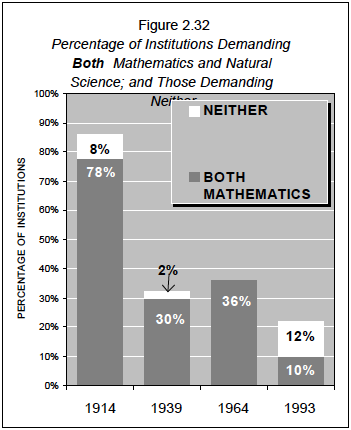
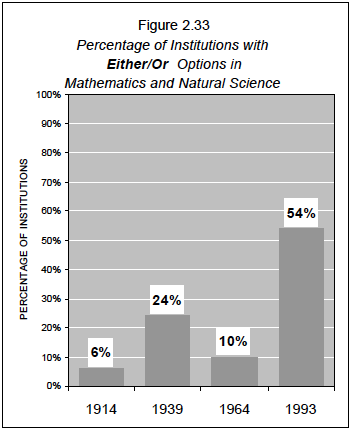
The changing incidence of the more permissive “science/mathematics option” is displayed in Figure 2.33. This option offers students an “either/or” choice between courses in the natural sciences and courses in mathematics. Such an option was found at 6 percent of institutions in 1914, 24 percent in 1939, 10 percent in 1964, and 54 percent in 1993.
Finding 23: The average credit weight of natural science and mathematics requirements declined substantially at the institutions possessing them, dropping for science from 11.5 percent of the baccalaureate requirement in 1914 to 5.8 percent in 1993 (see Figure 2.34); and for mathematics from 6.5 percent in 1914 to 5.1 percent in 1993 (see Figure 2.35).
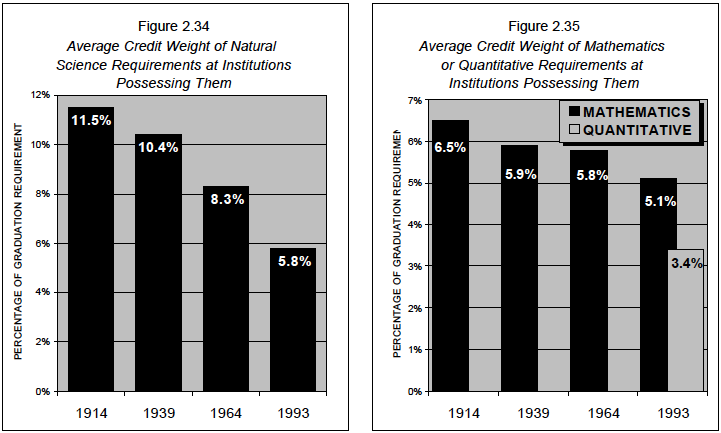
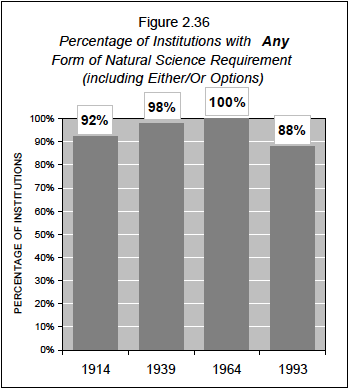
The changing total percentage of schools with either a natural science requirement or an either/or natural science/mathematics option is shown in Figure 2.36.
Finding 24: There has been increasing choice among science courses within science requirements. Prior to 1993, courses that counted toward fulfilling the natural science requirement were almost invariably grouped in clusters, indicating a highly structured choice among introductory courses in the principal natural sciences (see Figure 2.37). In mathematics clustering has remained the rule, even though the incidence of the requirement has diminished (see Figure 2.38 on page 40).
Figure 2.37 displays these trends in the natural sciences: in 1914, special curricular status in the natural sciences was accorded by 82 percent of all institutions in our study, 72 percent did so in both 1939 and 1964, but only 6 percent did so in 1993. Mandatory natural science courses have always been found at only a minority of the schools. However, single -subject clusters—wherein students select from among different courses in the natural sciences (e.g., biology, chemistry, or physics)—were by far most common, ranging from 70 percent of institutions in 1914, to 42 percent in 1939, to 56 percent in 1964. By 1993, however, this figure had plummeted to 2 percent, indicating a large proliferation of new science options, often, with a “softer” focus.
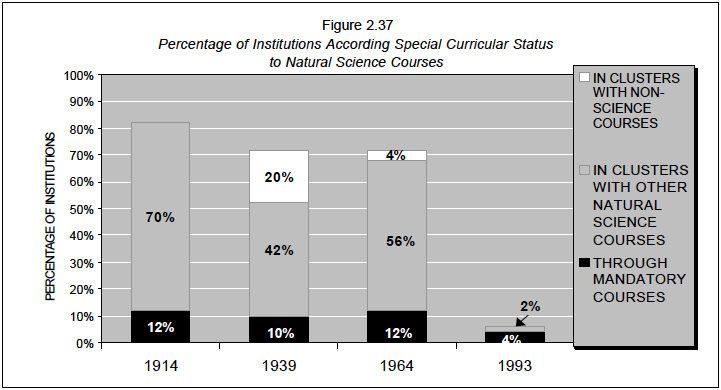
The situation is somewhat different in mathematics. The overall percentage of institutions according special curricular status to mathematics courses declined in each year examined: 96 percent in 1914, 52 percent in 1939, 28 percent in 1964, and 6 percent in 1993. The institutions requiring a mandatory mathematics course (in some cases, courses) also declined substantially: 41 percent in 1914 demanded at least one such course, but only 12 percent in 1939, 4 percent in 1964, and 2 percent in 1993. Moreover, unlike natural science courses, where the majority of the courses were found in single -subject clusters, mathematics courses were, especially in the earlier years studied—as shown in Figure 2.38 on page 40—placed in multisubject clusters (e.g., a student might have a choice among a course in math, Greek, or symbolic logic).
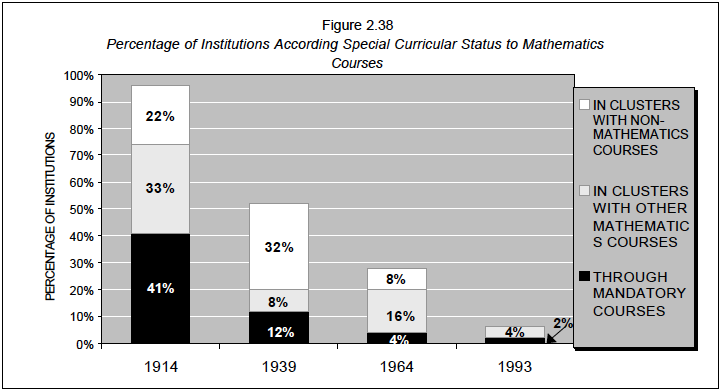
Distribution Requirements
Instead of requiring students to take a course in a specific subject, colleges may group several subjects into a single curriculum category. This has been the typical pattern within the social and natural sciences, but—until recently—less so in the humanities. Since students are being asked to spread credits among a number of possible fields these requirements are generally known as distributions.
Where the ratio of choice between the courses to be taken and the courses available is small it remains likely that students will be channeled into a small number of introductory courses, but as this ratio grows that likelihood progressively diminishes. This should be kept in mind as we review the growing proportion of general education programs composed of distribution requirements and the rapidly increasing ratios between the number of courses to be taken and those available. While college and university administrations are nowadays apt to point to the existence of distribution requirements in their catalogues as evidence that undergraduates still receive exposure to basic subject matter, the usual situation is vastly more latitudinarian than these assurances suggest.
If we define a distribution requirement as a curriculum category in which the student is asked to choose among courses in three or more subject areas, their increase in prevalence and scope, particularly after 1964, is quite dramatic.
Finding 25: There was almost a seven-fold increase in the number of schools possessing distribution requirements in the humanities from 1914 to 1993, with 80 percent having them in 1993 (see Figure 2.39). In the social sciences, the increase was more than seven-fold from 12 percent in 1914 to 88 percent in 1993 (see Figure 2.40). With respect to mathematics and the natural sciences, distributions were found at a majority of institutions throughout the period studied (see Figure 2.41).
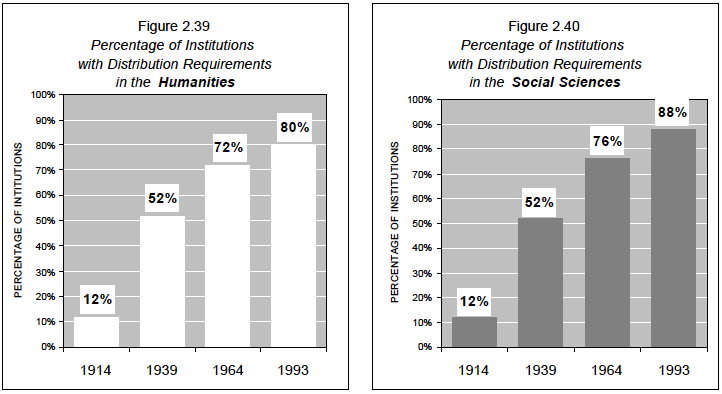
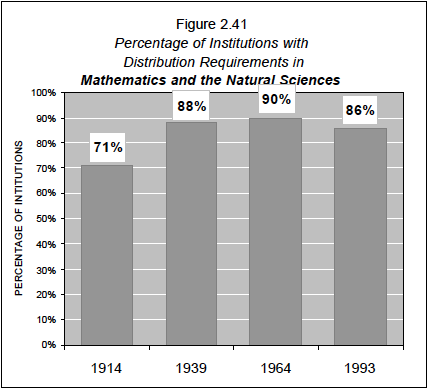
Finding 26: The average number of courses available without prerequisite within distribution requirements increased after 1964 by a factor of six in the humanities (see Figure 2.42), by a factor of almost seven in the social sciences (see Figure 2.43), and by a factor of three in mathematics and the natural sciences (see Figure 2.44). The average number of courses without prerequisites in 1993 was over five times greater in the humanities and almost four times greater in the social sciences than it was in the natural sciences.

The multiplication of course options without prerequisite, as shown in Figures 2.42 to 2.44, is a combined result of the rapid increase in the number of undergraduate courses and the very substantial diminution in the number of prerequisites. Under such circumstances, there is obviously a lowered likelihood that students will be exposed to the same basic courses or that students receiving the same degree will take many of the same courses.
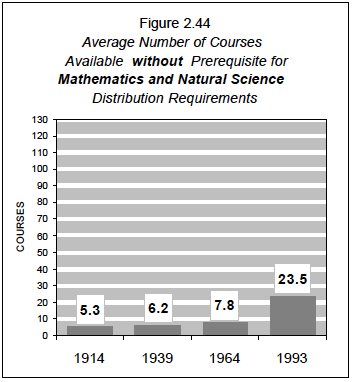
Finding 27: By 1993 distribution requirements not only existed at more schools but also composed more of the total credit value of general education programs than in any of the previous years studied. Indeed, in 1993 they were more than half again as large—constituting 61 percent of the credit weight of the total general education requirement—as they had been in 1964 (see Figures 2.45 below and 2.46 on page 44).
Figure 2.45 indicates the average percentage of the general education requirement comprised of humanities, social science, and natural science (including mathematics) distributions. As the average size of the general education decreases, the average percentage devoted to distribution requirements increases.
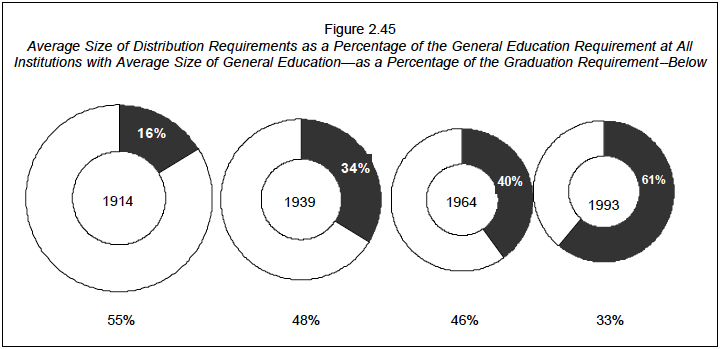
Figure 2.46 on page 44, on the other hand, displays the average credit weight of these distributions as a percentage of the graduation requirement at the schools having them.
Another point worth stressing is the emergence by 1993 of three new distribution categories: those consisting of courses with a “diversity” emphasis, those consisting of courses with a special focus on writing, and those made up of freshman seminars (see Figure 2.46).
“Diversity” distributions were found at twenty-five institutions in 1993, had on average about 44 courses available without prerequisite, and constituted an average of 3.8 percent of the baccalaureate requirement at the schools where they were found.24 An additional seven institutions required that a course under the “diversity” rubric be taken but allowed its credit value to be applied within one of the more standard distribution categories. Writing distributions were found at eight schools, had an average of 45 courses available without prerequisite, and composed an average of 3.4 percent of the baccalaureate requirement. Distributions made up of seminars (usually required in the freshman year) were found at fourteen schools in 1993, where they constituted 3.0 percent of the baccalaureate requirement. On average, for every one seminar required, there were 18 courses without prerequisite from which the student could choose.
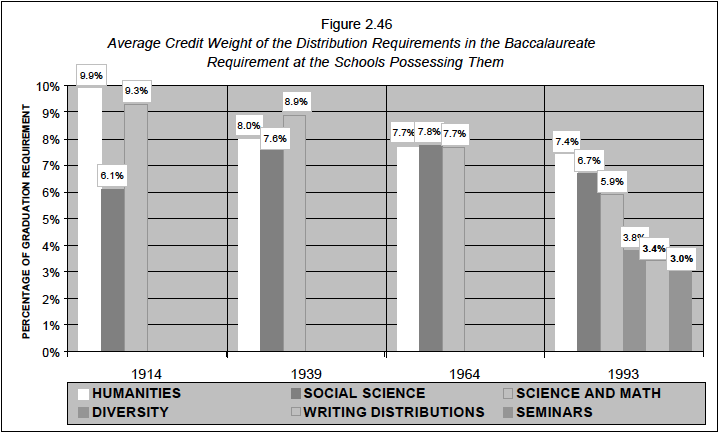
Hygiene and Physical Education
The notion of a rounded education has traditionally included training the body as well as the mind, though it was not until the latter part of the nineteenth century that physical education became a formal part of the undergraduate curriculum at most American colleges and universities. By the beginning of the twentieth century, however, courses in physical education and hygiene had become common components of general education and remain a typical part of it today. Nonetheless, the decline that has overtaken requirements in intellectual subjects also shows up in athletics and gymnastics, surprisingly, perhaps, in light of contemporary society’s preoccupation with fitness and preventive health care.
Finding 28: During 1914, 1939, and 1964, over four-fifths of schools had physical education requirements. By 1993 only a bit more than half had them (Figure 2.47). Hygiene requirements, either as an element of physical education or as a separate course, were found at a majority of the institutions in our study in 1914 and 1939, but at less than 20 percent in 1964, and at none at all in 1993 (see Figure 2.49 on page 45).
In the earlier years, when physical education courses were required, they more frequently carried credit toward graduation—and thus affected grade point averages. Thus, in 1914, 41 percent of all schools, and in 1939, 44 percent, gave credit for their physical education requirement. By contrast, only 18 percent and 22 percent did so in 1964 and 1993, respectively.
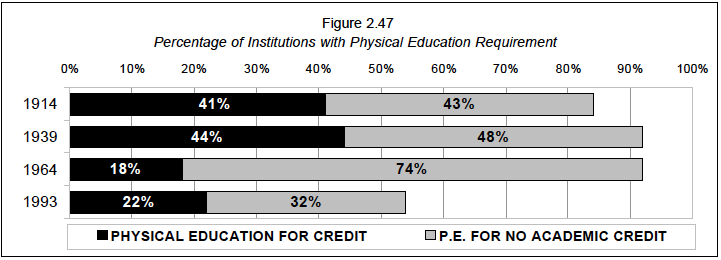
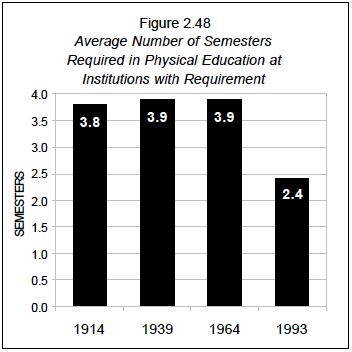
In addition, while the average number of semesters the student was required to complete in physical education hovered around 3.8 and 3.9 in the first three years covered by our study, it had dropped to only 2.4 by 1993 (see Figure 2.48).
For its part, required hygiene instruction, distinguishable from physical education by its focus on health issues and classroom format, had vanished from the catalogues by 1993 (see Figure 2.49 below).
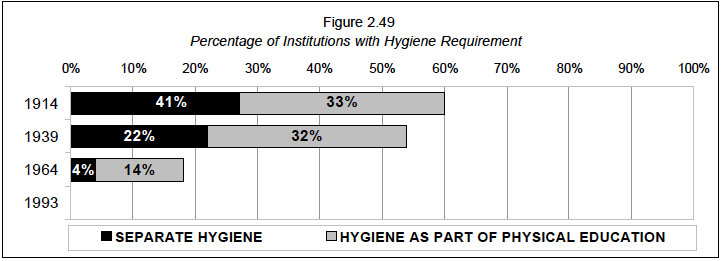
Chapter III
The Decline of Rigor
In analyzing the structure of the curriculum, we have asked the question: “How willing have the institutions in our study been to set priorities?” In analyzing content we’ve examined the nature of these priorities. Left unanswered is the question of how challenging general education requirements have been, to which we now turn.
To be sure, for a purpose like this, a catalogue study has real limitations. The demands made by reading assignments, the difficulty of writing assignments, the intellectual level of lectures and class discussion, and the stringency of grading cannot be divined from the pages of bulletins. Still, these publications do reveal a variety of significant data about the level of the demands made on undergraduates. Taken together, these data paint a discouraging portrait of diminishing rigor at the most prestigious colleges and universities in our land. Thus, by 1993 students graduating from these elite schools not only had fewer specific assignments to complete but were also asked to do considerably less in completing them.
A consideration of the degree of rigor in a curriculum bears on more than the amount, content, or depth of what a student learns. It also has implications for character formation. The ability to work hard, to persevere in exacting tasks, and to master detail are all critical in determining individual achievement. By the same token, the degree to which these qualities are found among a society’s leadership has a direct influence on that society’s overall strength and vitality.
To estimate changes in the level of the academic demands placed upon students we gleaned data from our catalogues about the following items:
1. The availability of exemptions from specific subjects otherwise required as part of the general education program.
2. Whether entering students deemed proficient enough in a foreign language to have the standard language requirement waived were required to proceed further in their language study—either by doing more advanced work in the languages they had mastered or by studying other languages.
3. The extent to which the science courses available to satisfy the general education requirement were stratified so that non-science majors could satisfy their general education science requirement by taking a different and less exacting introductory science course than those demanded of science majors.
4. Whether the required science courses entailed laboratory work.
5. The extent to which the courses available to satisfy the mathematics requirement were stratified so that non-science and non-mathematics majors could satisfy their general education mathematics requirement by taking a different and less exacting mathematics course than those demanded of science and mathematics majors.
6. Whether calculus was required to complete the standard mathematics requirement.
7. The frequency with which special capstone requirements, including theses and comprehensive examinations, were stipulated in the catalogues for graduation and/or completion of a major.
8. The length of the academic year, the academic week, and the standard class period.
Before proceeding it would be well to pause for a moment to consider what we know about the changes in the level of preparation of the students who entered institutions of higher learning during the period studied. If we have serious reason to believe it has declined, a diminution in rigor (as well as in structure and content) might well prove understandable. After all, to retain such students, institutions would naturally be tempted to relax internal standards. Yet, in such a context, the educational consequences of declining standards could be viewed as more harmful than they might otherwise be, since far from compensating for the deficiencies of secondary education, colleges and universities would only be compounding them.
To be sure, some would argue that as American higher education has become more democratic, standards have had to drop in order to accommodate generations of more socially diverse and less affluent students. It should be kept in mind, however, that the colleges and universities studied do not comprise a random sample of America’s institutions of higher education but constitute what is widely regarded to be the “elite” stratum. To the extent, therefore, that their standards have fallen, tomorrow’s “best” will probably compare unfavorably with the outstanding of today and yesterday.
Unfortunately, much evidence points to a decline in freshman preparation. We know, for example, that between 1964 and 1993 there was a drop of 7.3 percent in combined verbal and mathematics SAT scores, concentrated especially within the highest percentiles of test takers, the echelon from which the schools in our study still draw most of their students.25
Moreover, we also know that many schools, including some we examined, have reduced their reliance on SAT scores (and stopped publishing the range of scores within their freshman classes) in order to admit larger numbers of students from disadvantaged backgrounds. While it is frequently claimed that these students, despite their often lower test scores, have other aptitudes that equip them eventually to succeed, most observers concede that they are more likely to enter with significant gaps in academic preparation.
But the catalogues also provide some independent evidence that strongly suggests a decline over time in academic preparation. The most obvious are changes in the account of admission requirements. While these cannot be regarded as fully descriptive of the procedures used to determine admissions, and not as readily subject to quantification as are other items, the contrasts they provide—at least with respect to the difference between 1914 and 1939, on the one hand, and 1964 and 1993 on the other—are quite telling. In 1914, particularly, the admissions requirements were laid out in great detail and at considerable length, specifying, among other things, the texts students had to be able to translate to demonstrate foreign language proficiency, the books that had to have been read to display an appropriate grounding in English literature, and the type of problems that they had to be able to solve in order to show competence at the prescribed levels of mathematics. Most high school graduates today, to say nothing of their teachers, would probably find the prospect of having to satisfy such requirements daunting.
While there was some (though generally not a great deal of) variation among the admissions requirements as described in 1914, the 1939 catalogues stated them in far more general terms and used about 15 percent less space in their description than in 1914. By 1964 catalogue admission standards usually referred not to specified levels of proficiency but to the completion of a prescribed number of years in individual subjects during high school (there are, it should be noted, already examples of this practice in 1939). By 1993 the catalogues often stated admission requirements in the briefest and most nebulous terms, making it quite hard to determine how much proficiency or how many years of high school subject matter the student had to complete in order to be admitted. What we appear to be seeing here is the “relativization” of admission requirements, allowing attainment levels to be defined increasingly be the sending institutions instead of by the receiving ones. With a growing concern among even elite colleges that student bodies should meet standards of group proportionality, this practice obviously widens the latitude available to admissions officers.
There is one other piece of evidence that comes directly form our catalogues and dramatically underscores the problems our elite schools currently face in coping with freshman classes generally less well prepared and containing significant numbers of individuals deliberately chosen despite their academic shortcomings: the proliferation of what seem to be remedial courses in English composition.
As we have seen, a required course in English composition had been one of the most enduring features of general education. What we begin to notice, however, in the more recent years covered by our study is the development of second-tier composition requirements. In one variation of this system, a course (or sometimes a set of courses) constitutes the “standard option” to which students are normally admitted, while a second course (or set of courses) is reserved for specially placed students on the basis of test scores or counseling. In another variation, the composition requirement is waived for the best students, while the rest are distributed between a standard and a “special alternative.” And in some instances, most students are allowed to waive composition, but a special course is set aside for those deemed to require special help. Phrases like “slower paced,” “supplementary instruction,” or “deficiency in writing skills” (though rarely “remedial”) are used to describe these offerings. It is this less-than-standard or second-tier status that for our purposes places them under a strong suspicion of being remedial.
Second-Tier Composition Courses
Finding 29: There is no evidence of remedial composition courses (except for foreign students) in 1914. In 1939 one institution had a “second-tier” course (titled “Sub-freshman English”), and in 1964 three (6 percent) did. By 1993 thirty-five schools (70 percent) had them.
Second-tier composition courses not only increased greatly in number between 1964 and 1993 but also began to be commonly offered for credit. None of the schools having such courses in 1939 or 1964 awarded any credit for their completion. By contrast, in 1993, thirty-one out of thirty-five that had such courses awarded credit for them (see Figure 3.1). Moreover, in the earlier years completion of the “special course” invariably obliged the student to enroll in and successfully complete the standard offering as well. As of 1993, however, in only four of the twenty-six cases where a regular composition or writing requirement existed was the subsequent completion of that course also required.
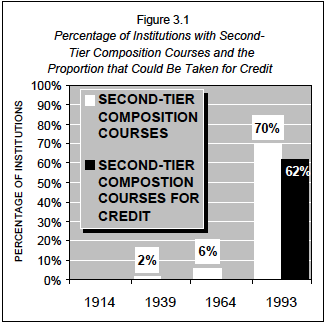
Exemptions
Throughout the period we examined, institutions within our study allowed students to win exemption from otherwise specified general education requirements upon some showing of unusual competence in a subject. Such a demonstration could be made in a variety of ways, including satisfactory completion of a prescribed number of years or courses in the subject in secondary school or the passage of an examination administered by the institution or (later), by an approved external agency (e.g., the Educational Testing Service Advanced Placement Program or the College Board).
We’ve already noted that the average percentage of the overall general education requirement from which a student could be exempted has risen steadily. Let us now look at the exemption opportunities that were offered for a variety of specific subjects.
Finding 30: The possibility of exemption from requirements in composition, foreign language, mathematics, and natural science shows a substantial, if irregular, increase after 1914. For each of these subjects, it increases sharply between 1964 and 1993.
English Composition
Exemptions from required composition or writing courses were found at 12 percent of the institutions studied in 1914, 42 percent in 1939, 50 percent in 1964, and 82 percent in 1993 (see Figure 3.2).
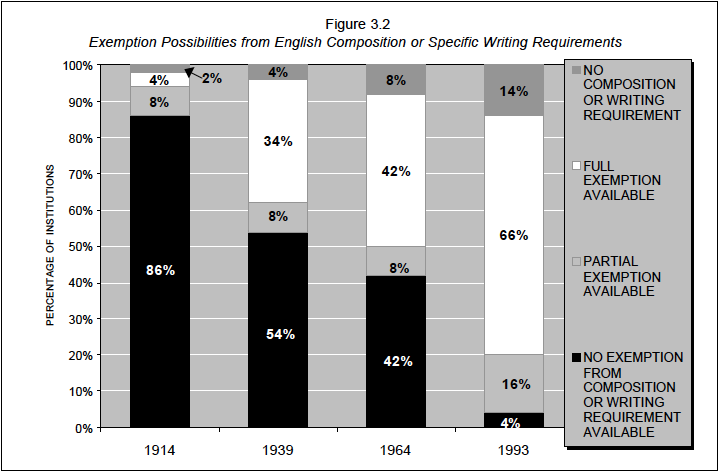
Foreign Language
With respect to foreign language exemptions, three basic policies can be discerned. The most rigorous schools allow no exemption from the language requirement per se, obliging unusually proficient students to either take their language courses at a more advanced level or to undertake the study of an additional language. A less rigorous program reduces but doesn’t eliminate the language credits proficient students must complete. The least rigorous institutions would allow students to avoid the language requirement entirely, usually reducing in the process the number of credits the student needs for graduation.
Finding 31: The percentage of schools with the most rigorous foreign language exemption policy (i.e., requiring the proficient to engage in further study) declined from 78 percent in 1914 to zero percent in 1993. Schools with partial exemption policies increased from 14 percent in 1914 to 72 percent in 1964, and then fell to 2 percent in 1993. The percentage of institutions either without a language requirement or allowing a full exemption rose from four (8 percent) in 1914 to forty-nine (98 percent) in 1993 (see Figure 3.3).
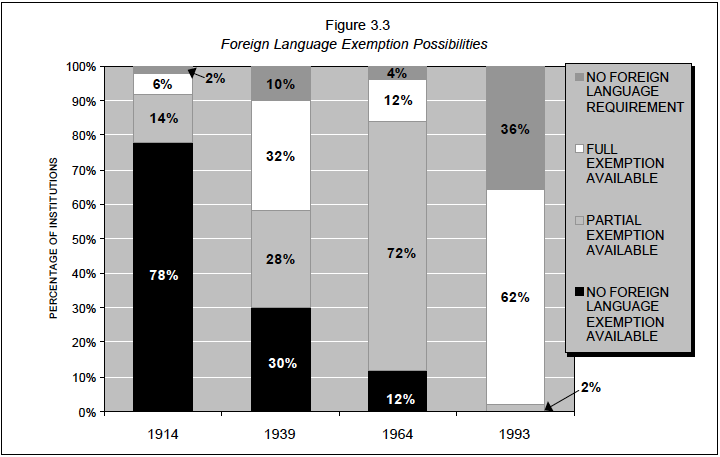
It should be kept in mind throughout this analysis that the number of schools without any language requirement for a baccalaureate in arts rose steadily over the total course of the period we covered, from one institution out of forty-nine (2 percent) in 1914 to eighteen out of fifty (36 percent) in 1993, while the size of the average language requirement (i.e., credit weight), as a percentage of the overall baccalaureate requirement, declined from about 16 percent to 9 percent.
Finding 32: In 1914 almost two-thirds of institutions studied demanded that students complete two foreign languages as a requirement for a baccalaureate degree. By 1964 none did (see Figure 3.4).
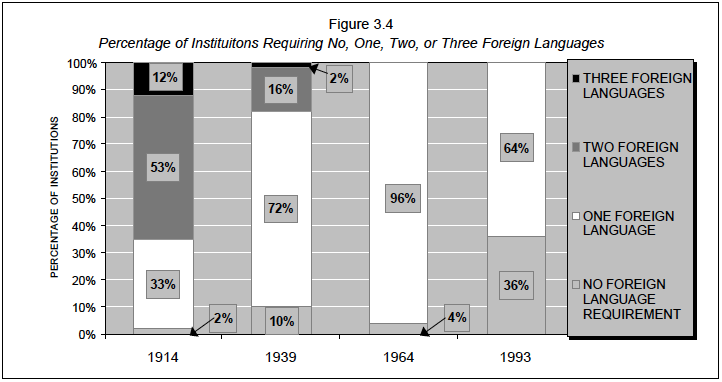
Mathematics or Quantitative Requirements
In 1914 only 21 percent of the institutions with mathematics requirements offered exemption; by 1964 this figure had risen to 56 percent; and by 1993 to 77 percent—which accounted for 34 percent of all institutions (see Figure 3.5).
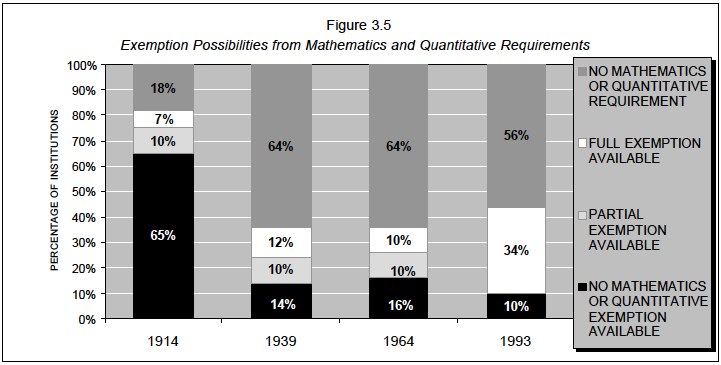
Natural Science
Figure 3.6 shows that natural science exemptions were unknown in 1914 and 1939. By 1964, however, they were allowed at almost a quarter of the schools with natural science requirements (22 percent of all schools); by 1993 more than half the schools with such requirements allowed exemptions (18 percent of all schools) (see Figure 3.6).
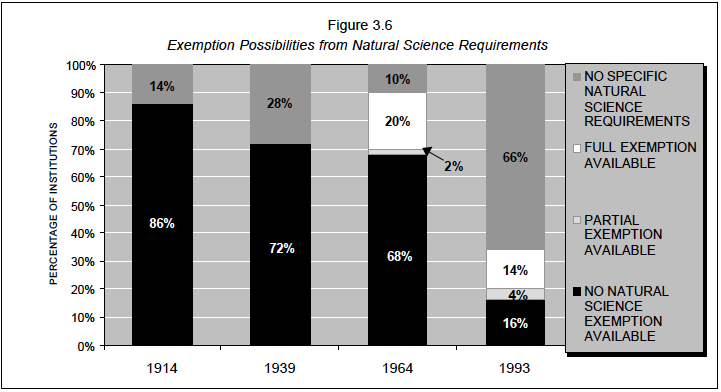
Stratification within Natural Science Requirements
Schools sometimes allow students who do not intend to major in a natural science to satisfy their science requirements by taking specially designed non-major courses. While these courses vary considerably, they typically contain less mathematics, are less likely to have laboratory requirements, and sometimes emphasize science applications more than do those courses meant for majors. They are usually specifically described as being for non-science majors, though their defining characteristic is their disqualification as prerequisites for elective courses within science majors.
There are, to be sure, arguments for the desirability of such courses. Non-science majors may learn more if they are not overburdened by having to master techniques and skills for which they have little aptitude and will have little use. The study of science applications—like science and cooking (an element in a course at Cornell in 1993)—may sometimes transmit knowledge of practical value for day-to-day life, or—like science and the environment (found at UCLA in 1993)—may have some interesting policy relevance. By the same token, however, the absence or diminution of mathematics and laboratory work, and the lack of experience as to how science is actually done, may impede a familiarity with science as an enterprise that we should want non-scientists to possess.
In any event, our concern here is more with the intellectual demands of the requirement than with its possible intellectual use, and it is clear that non-major science courses are less rigorous, in the sense that term would be ordinarily employed, than those capable of leading to advanced work. What then do our data reveal with respect to the changing prevalence of these options at the schools studied?
Finding 33: None of the institutions in 1914 had special courses set aside for non-science majors. As of 1939, however, these had been introduced at 24 percent of the schools we examined. By 1964, 40 percent of the colleges and universities with science requirements (or science/mathematics options) offered such courses. By 1993, 84 percent (or 74 percent of all schools) did (see Figure 3.7).
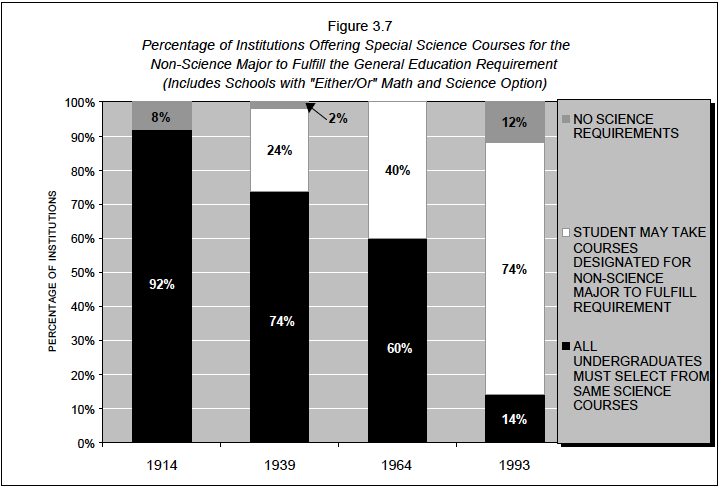
Natural Science Laboratory Requirements
Let us look next at the number of schools whose natural science requirement entailed completion of a laboratory component. (We counted as instances cases in which the laboratory requirement was part of the science course itself and those in which it was a separately graded but required counterpart to a science course.) In examining these figures it should be kept in mind that while not all science courses for nonmajors have laboratory requirements, many do.
Finding 34: In 1914, 1939, and 1964, the percentage of schools with laboratory components within the natural science requirements fluctuated between 74 and 84 percent. By 1993, however, the figure had plummeted to 30 percent (Figure 3.8).
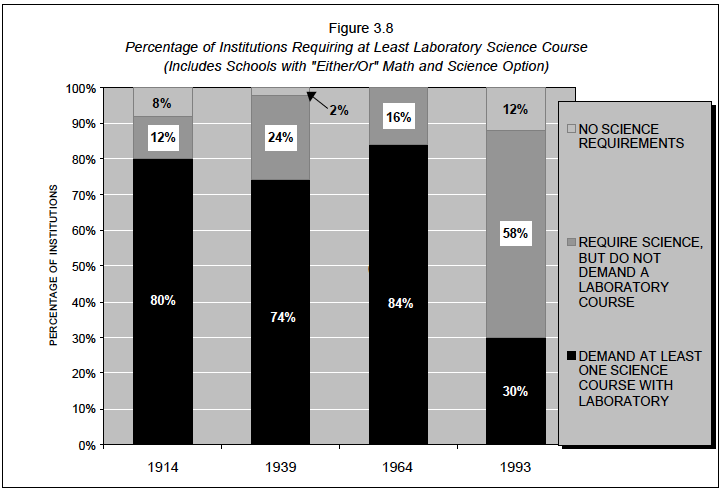
Stratification within Mathematics Requirements
Finding 35: In neither 1914 nor 1939 did the mathematics requirements at any of the schools examined allow non-science and non-mathematics majors to take special courses. Rather, they were expected to satisfy their requirements by taking the same introductory courses as opened the way to a major in mathematics or science. By 1964, however, 12 percent of the institutions had mathematics requirements with non-major options. By 1993, 38 percent of the institutions had such alternatives (see Figure 3.9 on page 56).
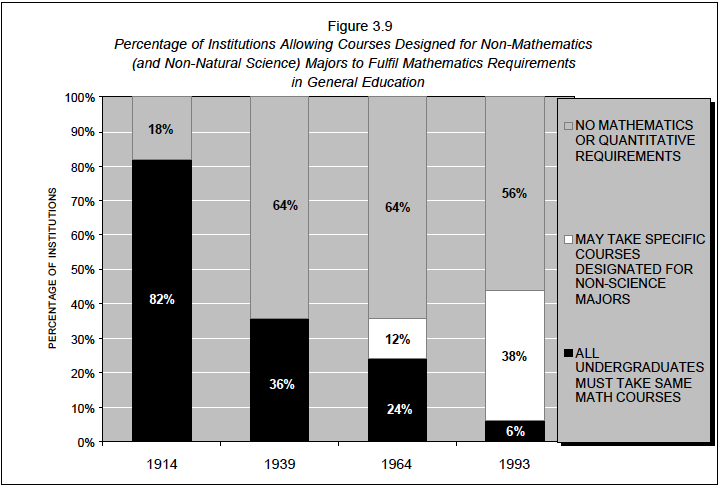
Calculus Requirements
Courses capable of satisfying mathematics requirements are often described as covering a variety of mathematical fields, including algebra, geometry, trigonometry, and calculus. While it is usually difficult to discern from such catalogue descriptions the level of difficulty at which a course is taught, we took the presence of calculus as a reasonably reliable signal that the course was challenging.
Finding 36: Calculus requirements have always been rather exceptional, though 1939 and 1964 were their peak years. In 1914 only three schools (6 percent) demanded that students go this far. In 1939 ten (20 percent) did and in 1964 seven (14 percent) did. By 1993 the figure had fallen to two (4 percent) (see Figure 3.10).
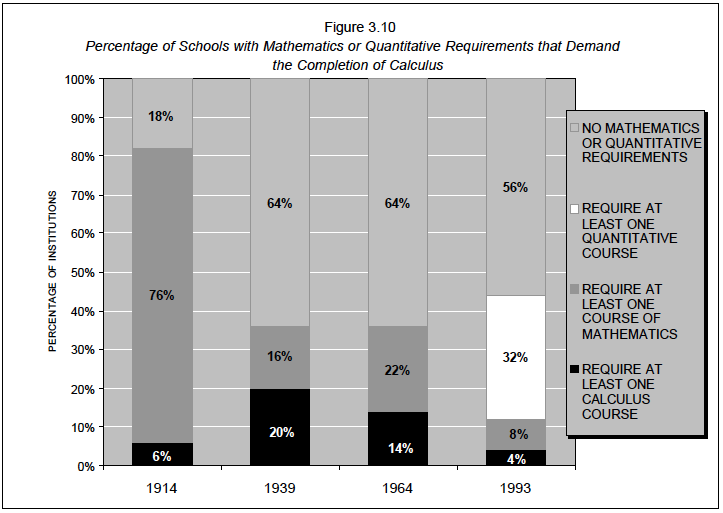
Theses and Comprehensive Examinations
Senior theses and comprehensive examinations are typically reported by students as being among their most challenging and worrisome responsibilities. Requiring either that a major research topic of some originality be completed or that mastery of an entire program of study be demonstrated, they entail the integration and analysis of a body of knowledge broader or deeper than is usually called for in any one course. Theses especially, and to a lesser extent comprehensive examinations, also entail writing at length and generally to a standard above and beyond that demanded in more casual, periodic assignments. Consequently, the prevalence of theses and comprehensive examinations provides another good measure of the rigor of undergraduate education.
Throughout the period studied, the institutions examined here have followed a variety of policies regarding theses and comprehensive examinations. Some have required them of all students completing a baccalaureate in arts, usually in the senior year and focusing on the subject matter of a student’s major. Others have left the decision to individual departments, while in some cases they were an obligation only for students seeking to graduate with honors.
Looking at the most comprehensive form of these requirements—that which applied to all students seeking a baccalaureate of arts degree—what is the trend?
Finding 37: Over half the schools studied listed a mandatory thesis or comprehensive examination as a general requirement for graduation in 1939 and 1964. In 1993, however, only 12 percent of the institutions listed them (see figure 3.11).
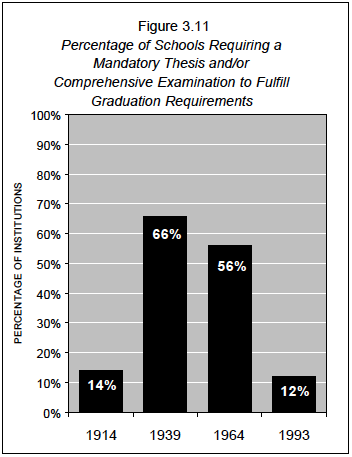
The fluctuations in the occurrence of mandatory theses and comprehensive examination requirements are shown in Figure 3.11. The relative absence of these requirements in 1914 is somewhat puzzling in light of the specificity of requirements and emphasis on writing otherwise found at the time. Possibly, it is related to the less than fully developed character of major requirements, with which both theses and examinations as expression of specialized knowledge have been generally associated. In 1914, for example, there were still seven schools without departmental majors, and even where present, majors constituted on the average about a fifth less of the total graduation requirement than they did twenty-five years later.
Length of Academic Year, Week, and Class Period
The amount of time students are expected to give to their studies can reasonably be assumed to have a direct relationship to the amount of subject matter they’ll encounter. It thus can be taken as a measure of the degree of content in the curriculum. It can also be seen as a test of the demands institutions are willing to place on the time of their students and hence of the rigor of their educational experience.
The catalogues can’t tell us anything directly about the amount of time students felt it necessary to put aside for study outside the classroom, although, to the extent that the class requirements they list seem more difficult, we can probably infer that there was more to be done in general. Many of the catalogues do reveal, however, a variety of significant facts pertaining to the duration of classroom instruction, including the length of the academic year, the length of the standard class period, and the prevalence of classes scheduled on Saturday. While in none of the years we examined did all of institutions report such data, most did, giving us a good basis to assess general trends.
Finding 38: The average number of days classes were in session (from the beginning of the fall semester or quarter to the end of the spring semester or quarter) dropped by almost a fifth between 1964 and 1993 (see figure 3.12). The length of the standard class period fell from an average of 59.8 minutes in 1914, to 58.7 in 1939, to 57.2 in 1964, to 53.7 in 1993 (see figure 3.13 on page 60). The number of institutions scheduling Saturday classes declined from 98 percent in 1914, to 79 percent in 1964, to only 6 percent in 1993 (see Figure 3.14 also on page 60).
Catalogues usually contain academic calendars indicating the beginning and end of sessions, the number of holidays, the duration of seasonal breaks, and the scheduling of final examinations. In fact, in none of the four years we examined did more than fifteen catalogues fail to do so. Excluding summer programs, holidays, breaks, and orientation (but including exam periods) and counting from the first day of class in August or September to the last day of class in May or June, we calculated the number of days classes were in session for each school in each academic year. This produced an average for thirty-four schools in 1914 of 204 days, for forty-three schools in 1939 of 195 days, for forty-six schools in 1964 of 191 days, and for forty-nine schools in 1993 of 156 days (see Figure 3.12). Consequently, the number of class days in 1993 was only slightly more than three quarters of what it was in 1914. In all but one of the years examined, over 60 percent of the institutions indicated the actual amount of weekly classroom time it took to accumulate one credit toward graduation, allowing us to derive the length of a standard class period.
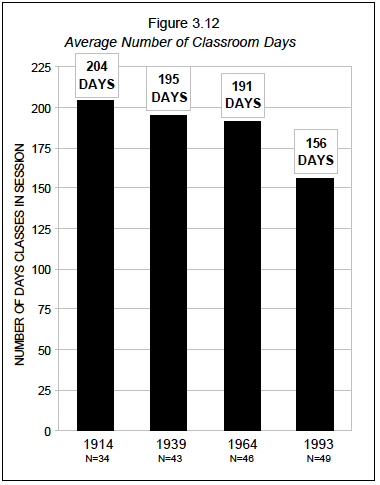
In 1914 the average length of the standard class period for the forty-six institutions whose catalogues provided this information was 59.8 minutes; for thirty-seven institutions in 1939, it was 58.7 minutes; for twenty-three institutions in 1964, it was 57.2 minutes; and, for thirty-one institutions in 1993, it was 53.7 (see Figure 3.13 on page 60). Thus, the average class period declined by 3 minutes and 30 seconds between 1964 and 1993 (a decrease of 6 percent) and declined by 6 minutes and 6 seconds from 1914 to 1993 (a decrease of 10 percent).
Most of the catalogues also listed the days of the week when classes were in session, allowing a count to be made in each year of the number of colleges and universities that held at least some on Saturdays. As Figure 3.14 indicates, of the forty schools for which such data were available in 1914, thirty-nine, or 98 percent, scheduled Saturday classes; of the forty-eight in 1939, forty-four, or 92 percent, scheduled them; in 1964, of the forty-three institutions that provided data, thirty-four, or 79 percent, did so; and, of the forty-nine colleges and universities whose catalogues included this information in 1993, only three, or 6 percent, had Saturday classes. (In light of the magnitude of this decline one might also note in passing the widespread impression within academe nowadays that even Friday classes are becoming a rarity.)
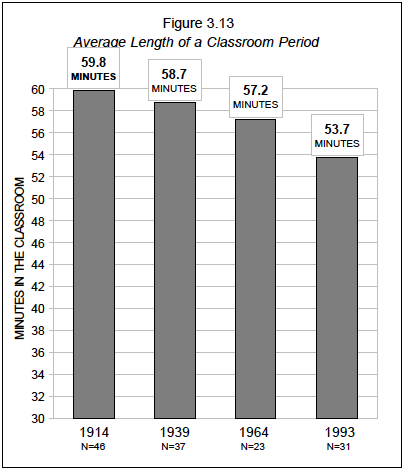
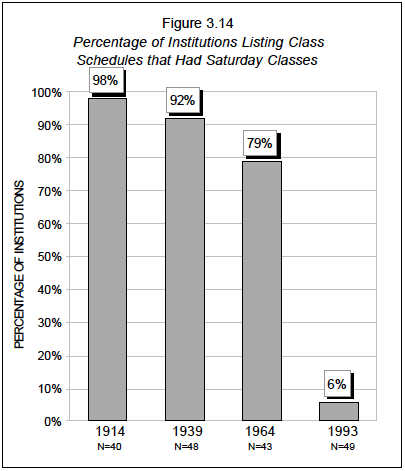
Conclusion
The Dissolution of General Education: 1914-1993
The prevalent unwillingness to set priorities within general education programs, together with the growing disinclination to insist on rigorous standards for completing them, suggests that undergraduate general education has become substantially devalued as an institutional objective. It also indicates that most institutions are no longer seriously committed to ensuring that their students are exposed to broad surveys of basic subject matter.
With respect to the structure of the curriculum, it is, of course, possible for a school to opt for a free choice among its courses as a matter of philosophy, reflecting a deliberate judgment that the type of students it enrolls will generally be able to profit from having unrestricted options. Programmatic pluralism is one of the greatest strengths of American higher education, and it is important that those students who can benefit from the widest range of choice have colleges and universities where such exists. Several of the institutions covered by our study (those that were explicit about not having specific requirements) may well have decided to provide such choices as a matter of considered educational judgment.
But the large majority have chosen instead to disguise virtually unrestricted options behind a facade of structure afforded by what are now generally called “distribution requirements.” While distribution requirements demand that a student spread his or her course selections among groupings carrying labels like “the humanities,” “the social sciences,” and “the natural sciences,” the courses contained within them—as we have seen—are in fact so numerous and diverse as to make it nearly impossible to predict what subjects the recipient of a baccalaureate will end up taking or to conclude that adequate guidance is actually being given to students. The presence of distribution requirements strongly suggests that most institutions recognize that their students expect and need guidance in attaining a broad-based education. However, when examined closely, these distribution requirements represent, in everything but name, a system of virtually unrestricted course selection.
A quite plausible argument can be made from this fact that general education has become a residual category of American academic life, given attention only to the extent that more important institutional objectives have already been secured. After all, the one clear virtue of the structureless curriculum is that it impedes little else. Having fewer challenging requirements, for instance, is likely to improve the retention of students, an especially important objective in an oversaturated higher education market. In addition, administrators can more easily avoid troubling the academic waters by abdicating judgment on the merits of the curricular claims of rival departments than by rendering it. Finally, in the absence of required survey courses, professors can divert less time from their specialized research.
Perhaps this is too cynical a view. To a substantial extent, the structured curriculum was dashed to pieces during the late 1960s and early 1970s, when the rage in higher education was a radical libertarianism based on notions of “relevance” and the assumption that a special insight belonged to youth. Idealism, therefore, has also played its role. But the outcome has certainly proved compatible with a variety of basic professional and institutional objectives that have steadily been gaining in importance since at least midcentury.
Earlier in the century, colleges and universities were generally much smaller and more preoccupied with teaching than is the case today. Consequently, they were more apt to possess a shared sense of pedagogical mission and a more unified system of governance than do their contemporary counterparts. This made it far easier for them to construct an integrated and sometimes unique approach to general education.
The rise of the research university has been an immense boon for the advancement of knowledge, and the democratization of higher education has, for many at least, created vast opportunities for personal improvement and upward mobility. But both have led—for reasons of increased size and internal specialization—to a situation in which academic institutions are no longer as constitutionally well-equipped as were their predecessors to define a unified vision of the essentials of undergraduate general education. The efforts most of them still make, however, to disguise this fact create the decided impression that they are uncomfortably aware that they have abandoned a major part of their perceived responsibilities.
Their discomfort is legitimate, because if they can no longer define educational essentials—and, in particular, no longer guarantee that students acquire a basic knowledge of their civilization and its heritage—we are in danger of losing the common frame of cultural reference that for many generations has sustained our liberal, democratic society.
Our data suggests that this danger is quite real. They reveal that during the last thirty years the general education programs of most of our best institutions have ceased to demand that students become familiar with the basic facts of their country’s history, political and economic systems, philosophic traditions, and literary and artistic legacies that were once conveyed through mandated and preferred survey courses. Nor do they, as thoroughly as they did for most of the earlier part of the century, require that students familiarize themselves with the natural sciences and mathematics. And particularly surprising, especially in a period when so much attention is given to the benefits of “multiculturalism,” the emphasis on foreign language training has been significantly diminished.
Our liberal, democratic society, to say nothing of our comfort and affluence, hardly represents the human norm, either in times past or with respect to most of the world today. Unless our citizens understand the ideas, practices, and circumstances that have produced this exceptional combination of freedom and prosperity one wonders if the norm will not eventually reassert itself. It has been said that the price of freedom is eternal vigilance, but without knowledge vigilance is blind.
In decrying the extent to which general education curricula have ceased to be vehicles for conveying the substance of our history, institutions, and traditions, we are not seeking to re-create some academic “Golden Age,” much less return to a curriculum geared to the instruction of a small social elite. The world has changed greatly since 1914, and happily, higher education is no longer the preserve of the chosen few. This, of necessity, must be reflected in a changed curriculum. Still, there is, if anything, even greater need for an education that can anchor students in the essentials of their heritage than there was in times past. This is so not only because more people participate in their decision-making processes than was ever the case in the past. The average citizen must therefore know more, not less, than he or she did at the beginning of the century. To ensure that he or she does, it is imperative that there be a significant recovery of civic responsibility among our colleges and universities.
It is of special importance that such a recovery take place among the institutions examined here, for it is within their walls that are nurtured not only America’s future citizens but its leaders as well. How this can be achieved in the necessarily much altered context of the modern academy raises an immensely complicated set of questions whose answers lie beyond the scope of this study. But answers must be found if our country is not to end up paying an extraordinarily high price.
1 Stanford University Courses and Degrees, 1993-94 (September 1993), 10.
2 Richard C. Levin, “Our Universities and Our Common Wealth,” remarks prepared for delivery at the Commonwealth Club of California, San Francisco, Calif., 10 May 1995, 7.
3 A variety of other catalogue studies cover shorter periods. See Paul L. Dressel and Frances H. DeLisle, Undergraduate Curriculum Trends (Washington, D.C.: American Council on Education, 1969), compares 1957 and 1967; Robert Blackburn et al., Changing Practices in Undergraduate Education (Berkeley: The Carnegie Foundation for the Advancement of Teaching, 1976), which compares the 1966-67 and 1973-74 academic years; while William Toombs et al. Open to View: Practice and Purpose in General Education 1988 (University Park, Penn.: Center for the Study of Higher Education, 1989) used these earlier studies as a baseline for their analysis of catalogues for 1987-88. In each case, their sample sizes were much larger than the population of institutions analyzed in our study (i.e., 322 for Dressel and DeLisle, 271 for Blackburn et al., and 700 for Toombs et al.) and contained a large number of institutional types at a variety of quality levels. Our study, apart from its much broader historical scope, is distinct in focusing on a small but unusually important subgroup of institutions and in presenting a considerable body of highly detailed data not found elsewhere.
With respect to those areas where the data from other studies and our own cover common ground, for example, the decline in the size of the general education requirement as a proportion of the baccalaureate degree during the late sixties and early seventies and the trend away from specific requirements and toward free electives, the data are comparable, as is evident in the comparison between Dressel and DeLisle’s data for the sixties and Blackburn et al.’s data for the late sixties and seventies..
4 General education as here defined includes those courses or areas of study that an institution demanded of all students seeking a baccalaureate in arts degree, irrespective of major field. For example, at Brown University in 1964, all entering freshmen had to complete the following general education requirements to graduate with a Bachelor of Arts degree:
• 1 year of English Composition, described as including “The art of composition. Training in rhetoric and analysis of expository prose.”
• “A competent control of one foreign language—Chinese, Greek, Latin, French, German, Italian, Russian, Spanish—and an introductory knowledge of the associated culture and literature, to be demonstrated by passing in college a foreign language or literature course at the fourth-semester level or higher.”
• A year of work in seven of the following:
1. Linguistics, Mathematics, or Philosophy
2. A Physical Science
3. A Life Science
4. Literature
5. Art, Music, or Religious Studies
6. History
7. A social study, other than History
8. An additional year of work in a subject already taken from the list of subjects above (a list of specific courses eligible to meet the requirements was provided)
• A year of physical education for all freshman, plus the demonstration of competency in swimming.
See: “Catalogue of The College and Pembroke College for the years 1964-1966,” The Bulletin of Brown University (November 1964): 78-79; 323.
5 We used “America’s Best Colleges,” from U.S. News & World Report, national rankings published 16 October 1989, the year we began collecting this data. The institutions, in alphabetical order, are: Amherst College, Barnard College, Bates College, Bowdoin College, Brown University, Bryn Mawr College, California Institute of Technology (Throop College of Technology in 1914), Carleton College, Colby College, Colgate University, College of William & Mary, Columbia University, Cornell University, Dartmouth College, Davidson College, Duke University (Trinity College in 1914), Georgetown University, Grinnell College, Hamilton College, Harvard University, Haverford College, Johns Hopkins University, Massachusetts Institute of Technology, Middlebury College, Mount Holyoke College, Northwestern University, Oberlin College, Pomona College, Princeton University, Rice University (The Rice Institute in 1914), Smith College, Stanford University, Swarthmore College, Trinity College of Hartford, CT, University of California at Berkeley, University of California at Los Angeles (State Normal School, Los Angeles in 1914), University of Chicago, University of Michigan at Ann Arbor, University of North Carolina at Chapel Hill, University of Notre Dame, University of Pennsylvania, University of Virginia, Vanderbilt University, Vassar College, Washington & Lee University, Washington University in St. Louis, Wellesley College, Wesleyan College, Williams College, and Yale University.
6 In most instances, the archives of the colleges and universities in our study were able to provide the catalogues that covered the academic years examined. In the few instances where this wasn’t the case, catalogues from a proximate year were used. Thus, with 1914 catalogues unavailable for Columbia University, Brown University, Hamilton College, Washington University, and the College of William & Mary, we used instead the 1911-12 catalogue for Columbia University; the 1913-14 catalogue for Brown University, Hamilton College, and Washington University; and the 1915-16 catalogue for the College of William & Mary. The following catalogues were substituted for the 1939-40 academic year: for Barnard College, Georgetown University, and Oberlin College, the 1938-39 catalogue, and for Cornell University and the University of Michigan-Ann Arbor, the 1940-41 catalogue.
7 Our study concentrates on the limitations placed upon what students could take rather than what they actually took. This is one of Clifford Adelman’s primary objections to curriculum studies based on college catalogues (Tourists in Our Own Land: Cultural Literacies and the College Curriculum [U.S. Department of Education: October 1992], 14-15). He does concede, however, that catalogues have their virtues. They are official institutional records “one can use them to mark long-term changes in curriculum, both in terms of particular fields and college graduation requirements [and] they reflect the birth, growth, mutation, and decline of disciplines, and the changing values and missions of different types of colleges.” Given the special nature of our study, they were the only uniform source of data available.
8 A potential objection to using a longitudinal approach in a study of elite institutions is that an institution’s standing can change over time. Hence, if some of the colleges and universities were regarded as “elite” in 1993 but had lower standing in earlier years, the changes observed over time might be less a function of changes in “elite education” per se and more changes in the status of some of the institutions studied.
Doubts on this score, however, can be laid to rest for several reasons. First, only a few of the schools in the group examined could arguably be said to have undergone a marked change in status, among them is UCLA, which was a normal school in 1914 and didn’t rise to the status of a major research university until after World War II; Rice University, which was only two years old in 1914; and a number of other institutions like Pomona College, which were well regarded regionally but probably not considered of top national caliber. Second, the objection would gain more weight if the evidence showed a trend toward the strengthening of curricular substance and rigor over time. Under those circumstances, some of the changes might reasonably be attributed to the rising status and concomitant improvement of programming at particular institutions rather than any across the board changes at elite institutions considered as a group. The data reveal, however, a pattern of decline with respect to substance and rigor, the opposite of what one might expect the rising status of particular institutions to produce. Moreover, our indicators show the sharpest declines between 1964 and 1993, a period during which every institution studied had clearly attained high rank.
Finally, to make absolutely sure that changes in status had little effect on the patterns found in our data, comparisons were run involving several key variables (e.g., the size of the general education requirement; the number of courses with prerequisites; the prevalence of specific requirements in fields like history, language, literature, and philosophy; and our indicators of rigor like laboratory and theses requirements) between “Ivy League” and “Seven Sister” institutions on the one hand, and the remaining institutions in the population studied on the other (the purpose being to isolate a subgroup of universities and colleges that were indisputably prestigious throughout the entire period covered). The comparison showed no major difference in the pattern of curriculum change between the two groups.
9 We defined a “cluster” as a group of courses wherein the student was required to take a set amount of courses in which the ratio between the number of courses the student had to take and the number of courses designated as available was one to six or more. We have termed courses occurring in such clusters “preferred courses.” In a single-subject cluster the courses are all in a single discipline. For example, if a requirement states that a “student must complete one course in history” and the catalogue designates three history courses to chose from, those three history courses form a single-subject cluster. If, on the other hand, there are nine history courses available to fulfill the requirement, then, by our definition, there is no clustering.
In a multi-subject cluster, the ratio between the number of courses the student had to take and the number of courses available was also one to six or more; however, the courses available are drawn from more than one discipline. Thus, a requirement that asks the student to complete one course in the humanities—and the only three courses open to complete the requirement are introductory courses in literature, philosophy, and religion—is an example of a multi-subject cluster. Any single- or multi-subject requirement wherein in the ratio of courses to be taken and courses available was less than one to six was not considered as part of a cluster.
10 Indeed, such changes as occurred were as likely to involve moderate shifts in subject matter emphasis as the loosening of constraints, and few general education curricula lost a readily discernible design. In fact, within some general education programs, a modest countertrend was evident between 1939 to 1964 (manifest primarily in additional history and social science requirements), reflecting the renewed commitment after World War II to “civic” education.
11 To determine the proportion of the baccalaureate requirement that the general education requirement constituted for each of the four years examined, each institution’s required units for general education in that year were totaled and then divided by the minimum number of units required to complete a baccalaureate degree. Next, an average was computed by totaling the percentages of the graduation requirement devoted to general education at each institution and dividing that total by the number of institutions studied in that year. The number of institutions was fifty in 1939, 1964, and 1993. However, in 1914 only forty-nine schools were covered, as UCLA was still the State Normal School, listed in the catalogue as “a two-year women’s teaching college.”
12 A mandatory course is one that a student must take in order to complete the general education requirement. In deciding what was a mandatory course, we treated foreign language courses generically; that is to say an institution with a foreign language requirement was considered to have a mandatory course in foreign language even if—as was usually the case—students could choose the language they would study from among several offered.
13 For the purpose of counting courses, only courses open to undergraduates were included. We did not count multiple sections of the same course and counted cross-listed sections only once. Moreover, we did not differentiate among those of year, semester, or greater length. Each course, however long, was counted as one course. In the early years of our study, the number of year-long courses was considerably greater than it is now.
14 The growth in the number of courses is not by itself a bad thing, being very frequently the natural result of the growth of knowledge and, in some cases, the development of whole new fields. For example, in 1914 psychology courses were frequently found within philosophy departments, only later becoming independent programs. The potential problem is not with the number of courses that the catalogues contain but in the lack of safeguards against students enrolling in them without adequate preparation.
15 Prerequisites are described in catalogues in a variety of ways. Some are determined by general rules for taking course sequences that apply uniformly to all courses or that apply to courses taken within particular departments. Others are simply conditions listed next to specific course descriptions—usually the completion of a specific prior course or receipt of prior approval from the course instructor.
16 Stanford University Courses and Degrees 1993-94 (September 1993), 408.
17 Courses and Programs of Study for the Academic Year 1992-93, the College, the University of Chicago (17 April 1992), 237.
18 Record of the University of North Carolina at Chapel Hill: Undergraduate Bulletin Fall 1993. Fall 1994 (1993), 118.
19 While specific required courses in rhetoric were never found at a majority of the institutions studied, rhetoric was, according to the catalogue descriptions, an important component of many English composition courses.
20 In the original report, we counted courses as being required in a particular subject when they were taught by the department responsible for that subject. For that reason, we did not count the courses comprising Columbia College's Core Curriculum (1993-94 catalogue) as required courses in literature (two terms), art (one term), music (one term), or logic and rhetoric (one term). Upon reconsideration, we have decided to count these core courses as required subject matter courses.
21 Although there were only two schools with preferred philosophy courses, one—Georgetown—required both an ethics course and an introductory course in philosophy.
22 With the exception of Georgetown and Notre Dame, the nature of the religion courses described in the catalogues was remarkable secular, falling evenly between survey courses of world religions and the historical and literary aspects of the Bible.
23 Examples of courses that could fulfill quantitative requirements in 1993 include Industrial & Labor Relations, City and Regional Planning, Biology and Society at Cornell and Public Opinion or American Legislative Behavior at Bates.
24 The specific content of these diversity requirements—all of which offered the student a choice among a large number of courses—was not especially reassuring. While these requirements have most usually been justified by reference to the need for preparing students to live in an increasingly diverse world, only four appeared to focus entirely on foreign societies. The others lumped courses of this nature with those preoccupied with the status of “marginalized groups” in the United States, a thematic emphasis frequently associated with tendentious and politically committed styles of teaching. Indeed, a polemical mission was sometimes advertised explicitly—for example, in the title of the “Social Justice Requirement” at Haverford or the “Recognition and Affirmation of Difference Requirement” at Carleton College.
Needless to say, whatever the intellectual merits of these subjects, their impact on the structure of the curriculum further swells the proportion of the general education requirement, consisting of distributions instead of more specific requirements.
25 According to the Educational Testing Service (Princeton, N.J.), out of a possible score of 800, the 1964 verbal SAT scores averaged 475, the math was 498; in 1993 the verbal scores averaged 424, the math 478. This translates to an 11 percent drop in verbal scores from 1964 to 1993, and a 4 percent drop in math scores.





